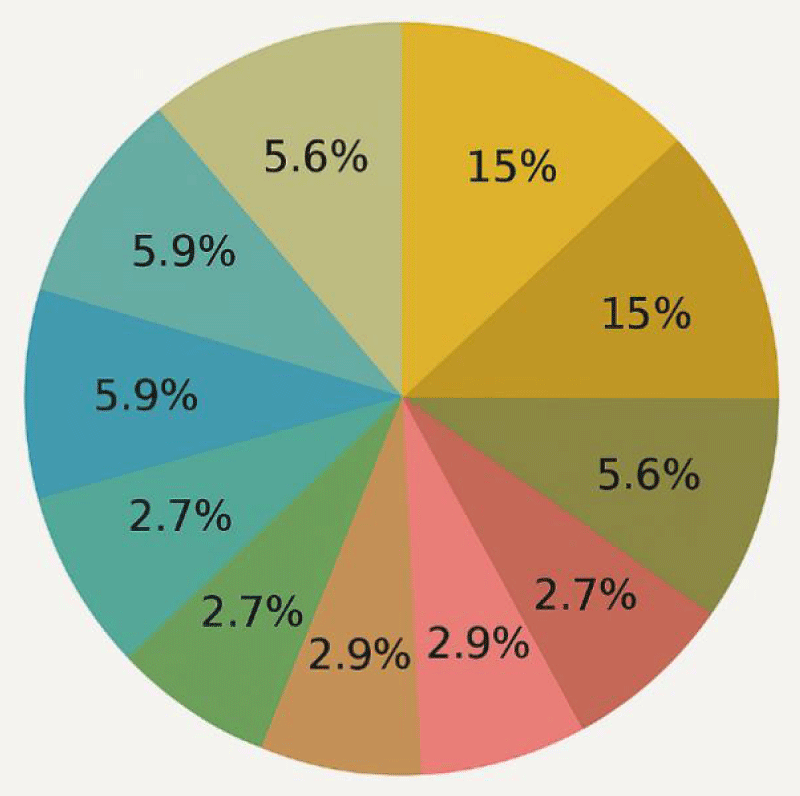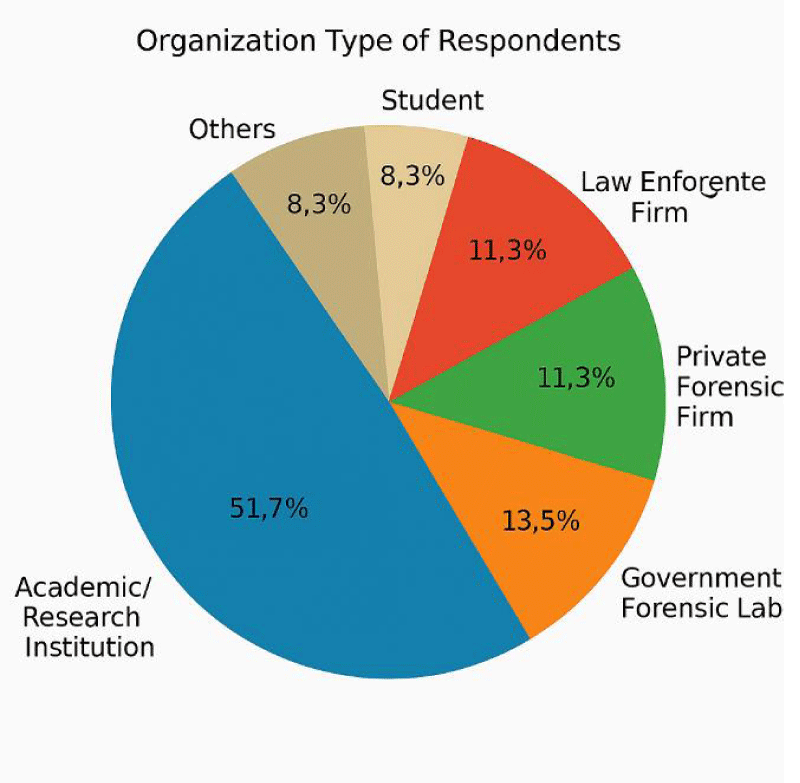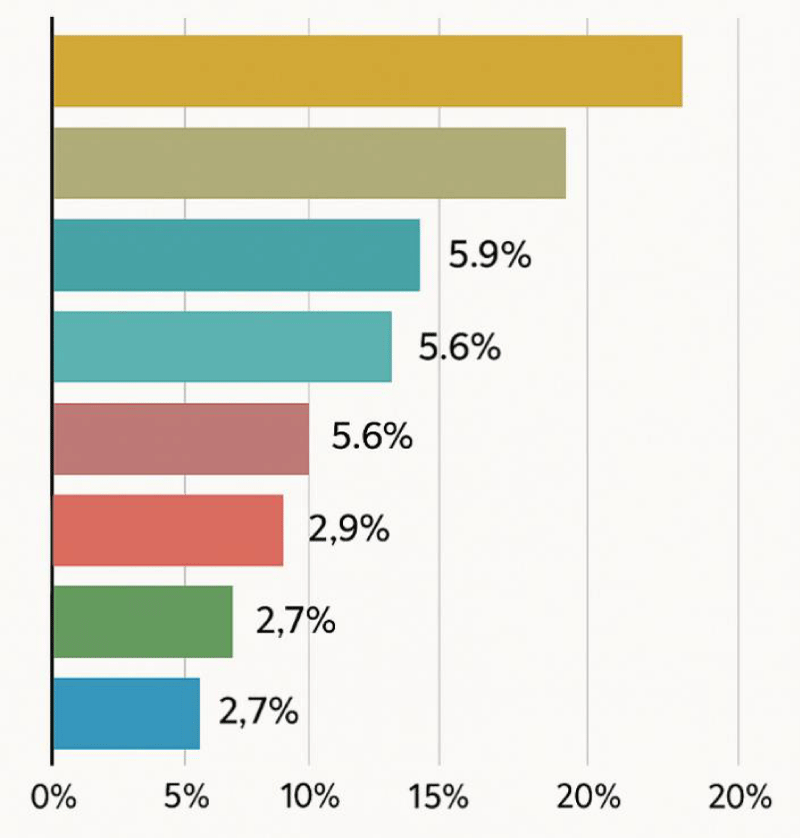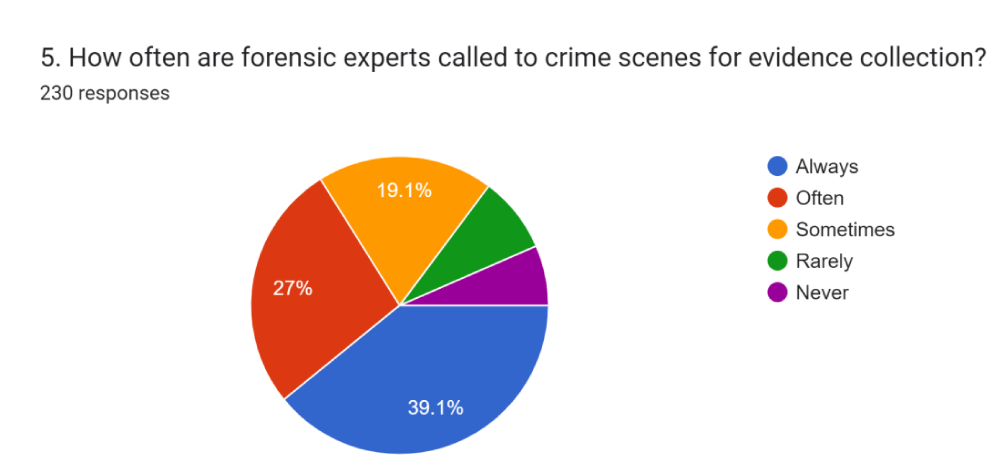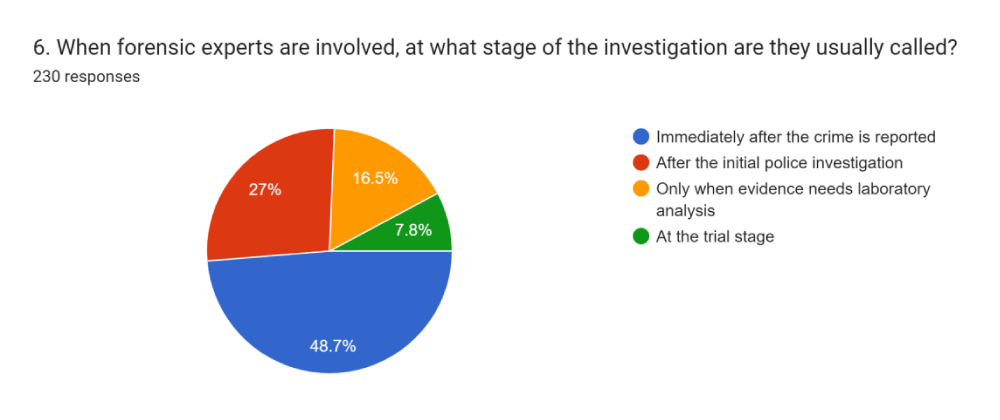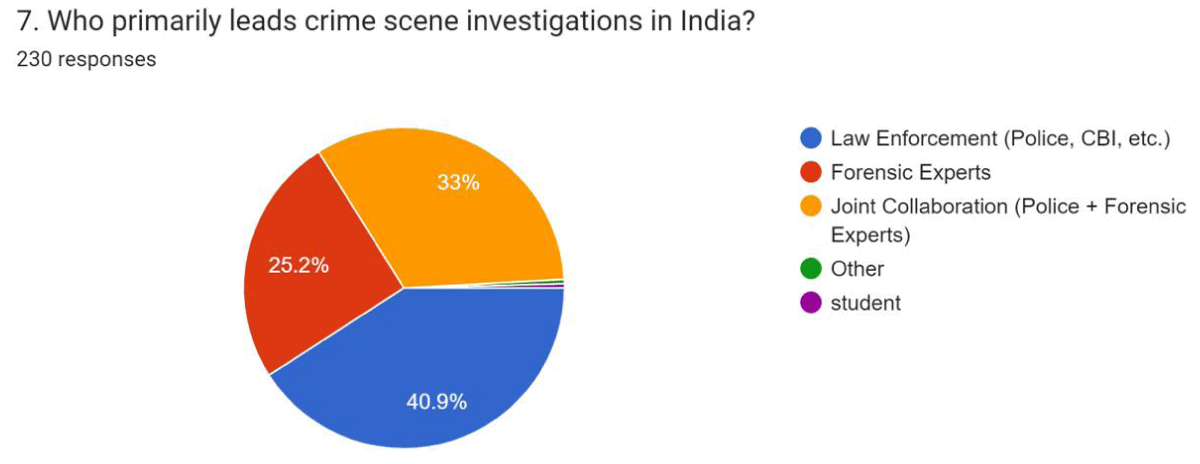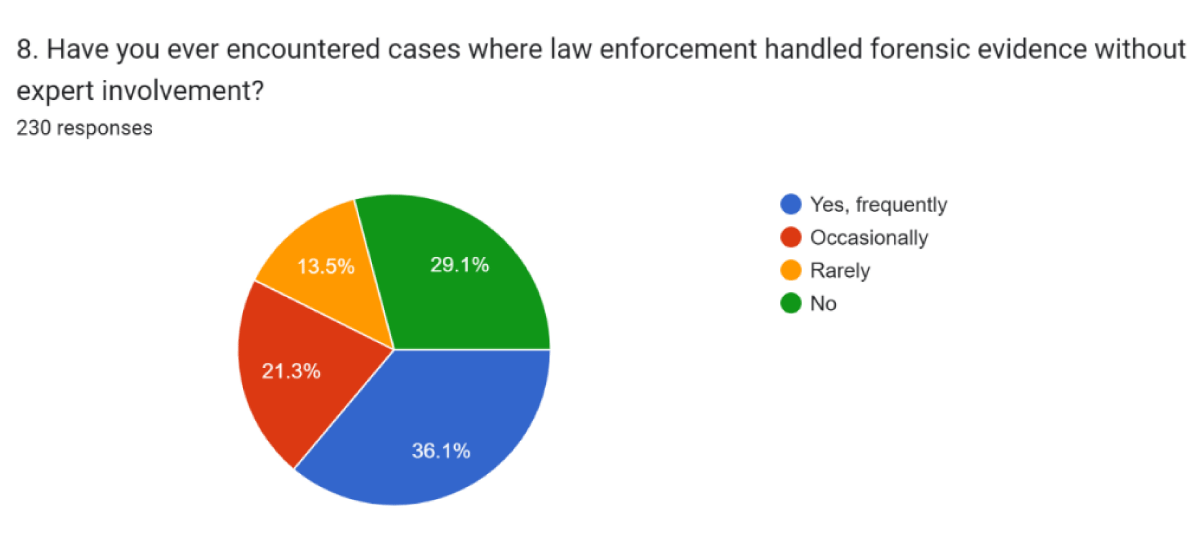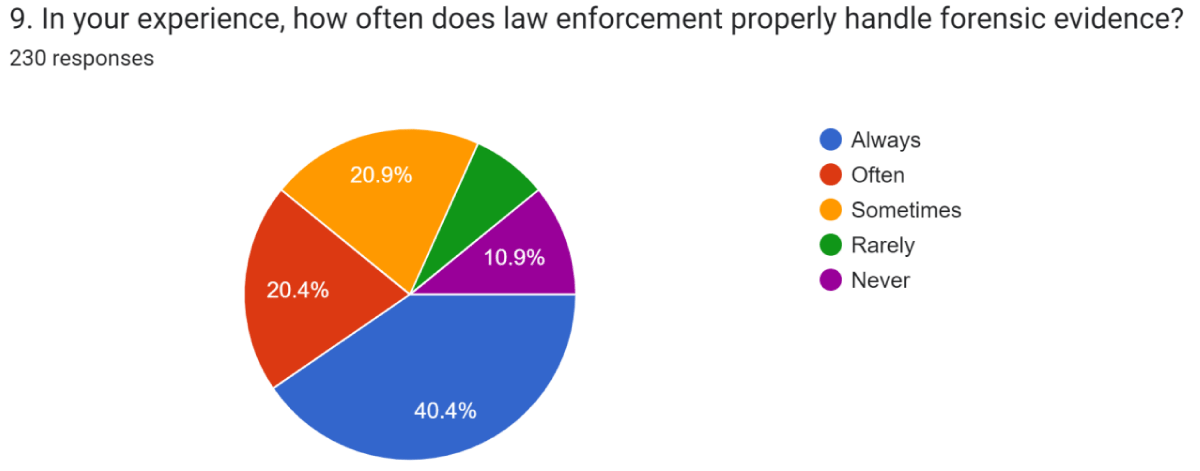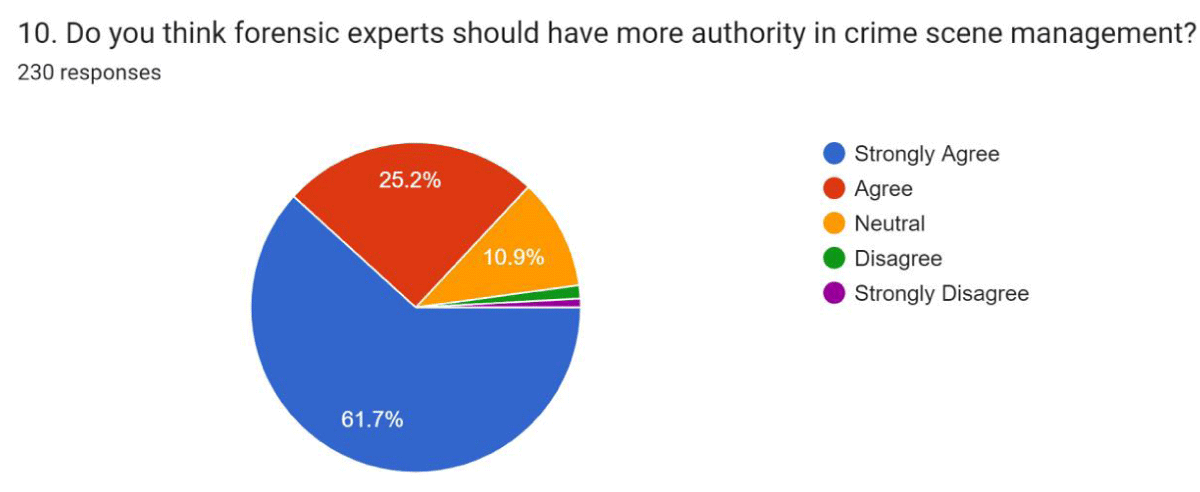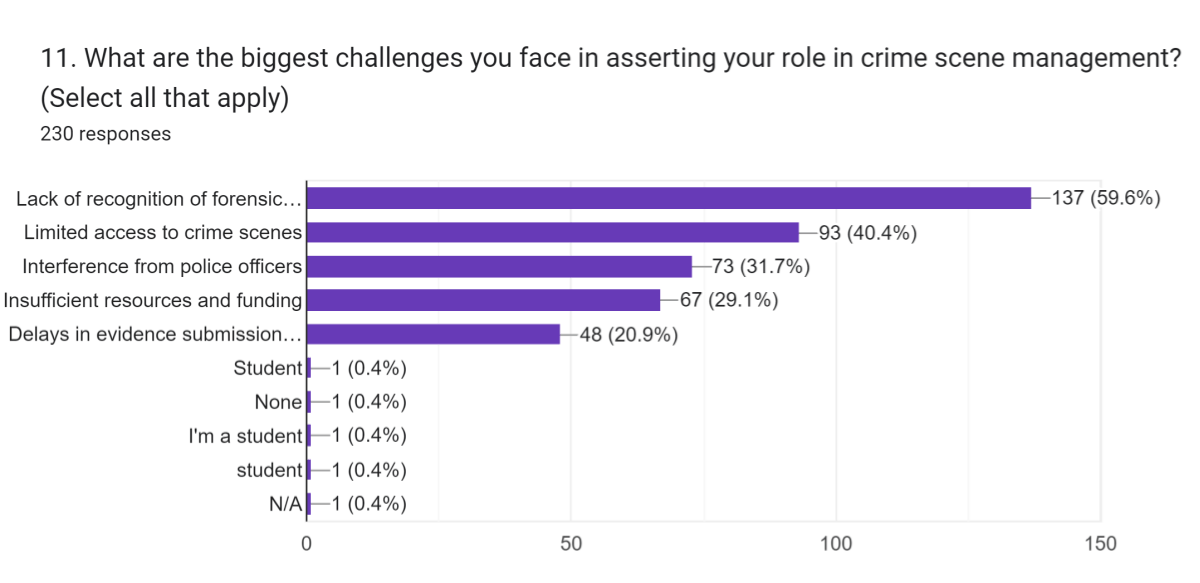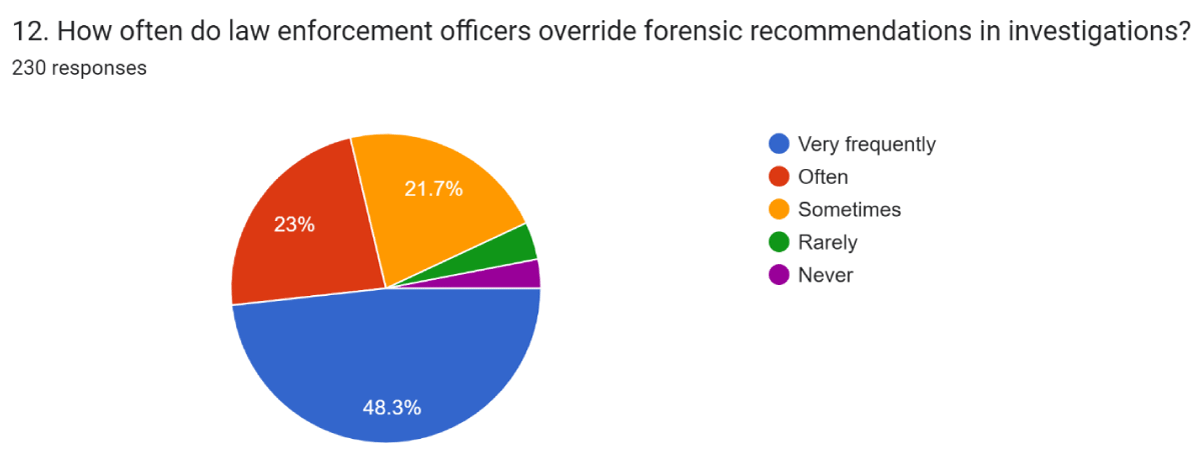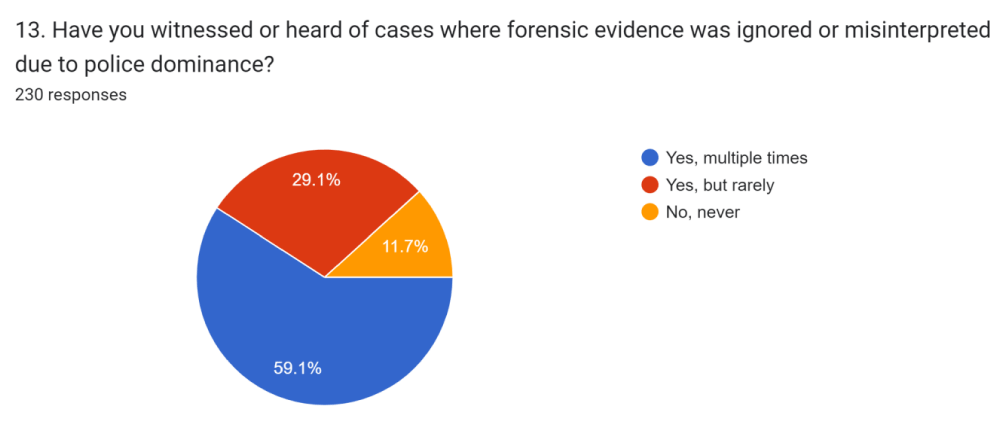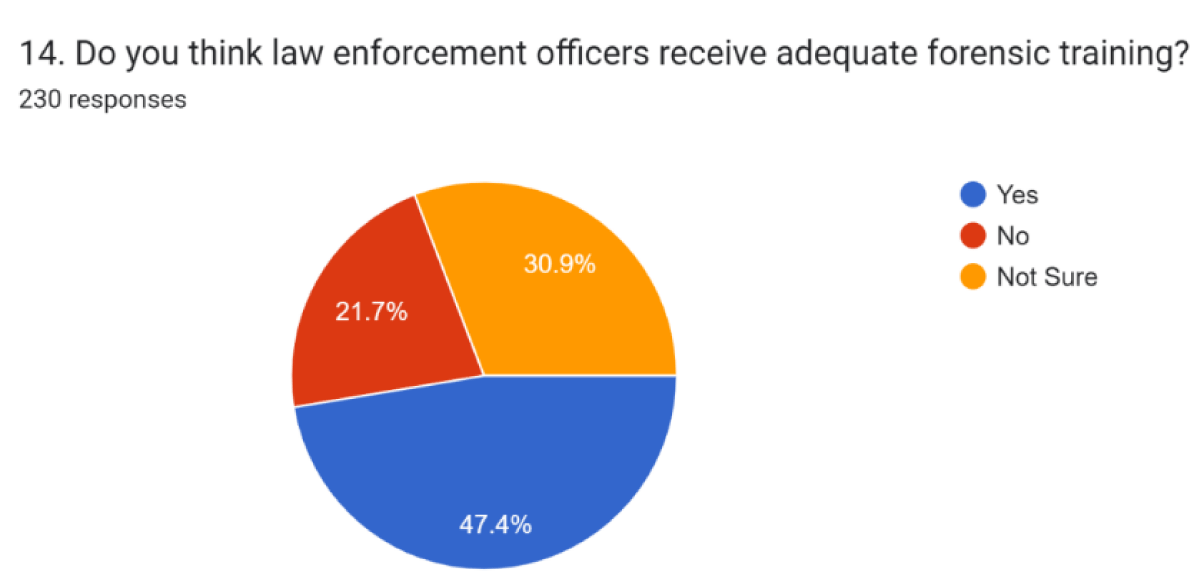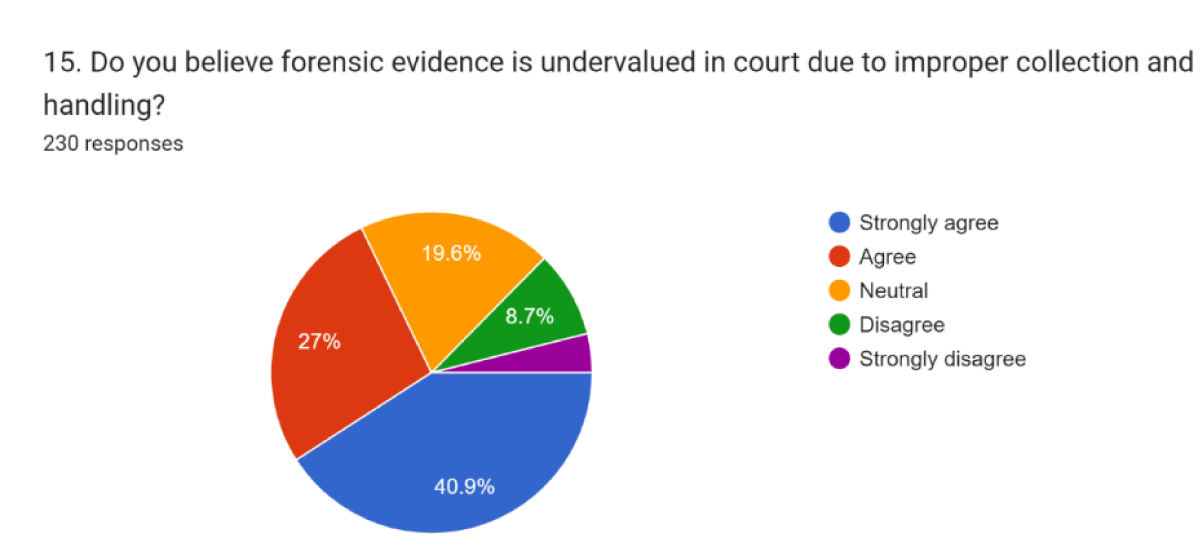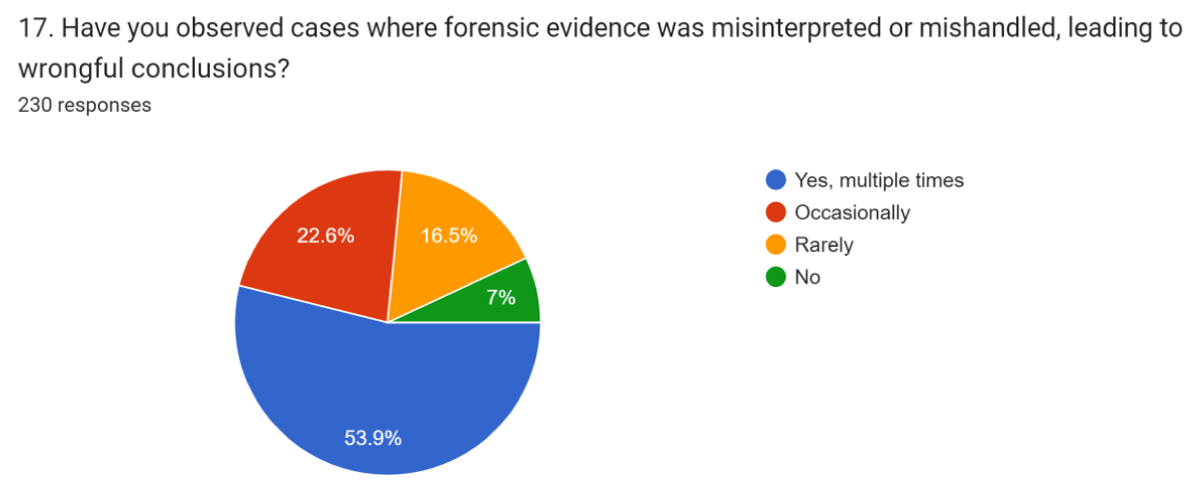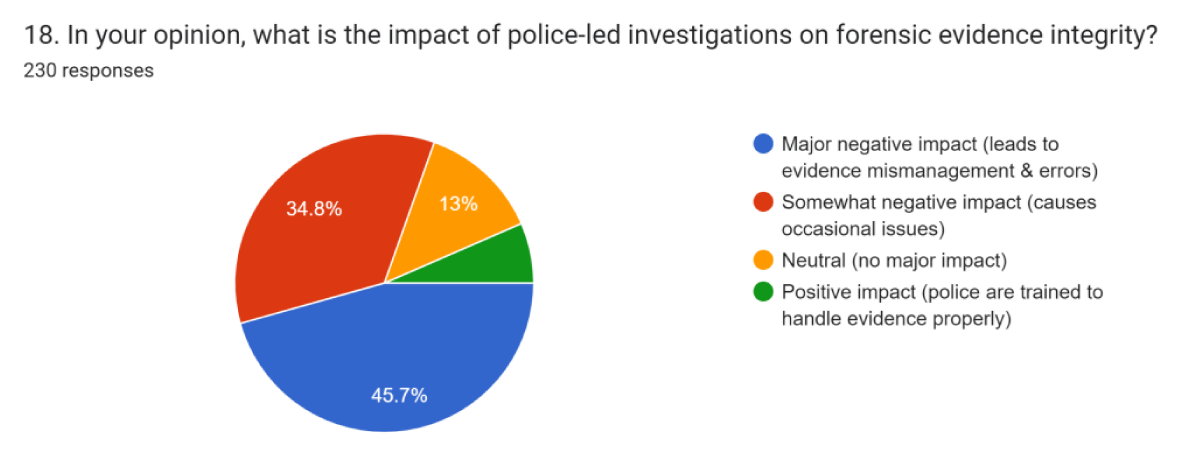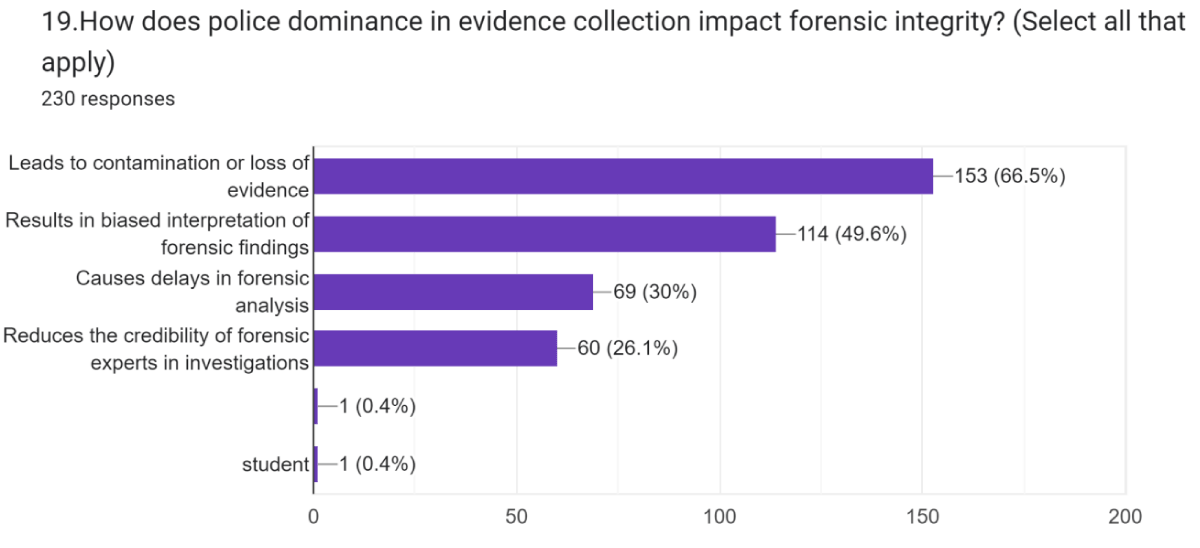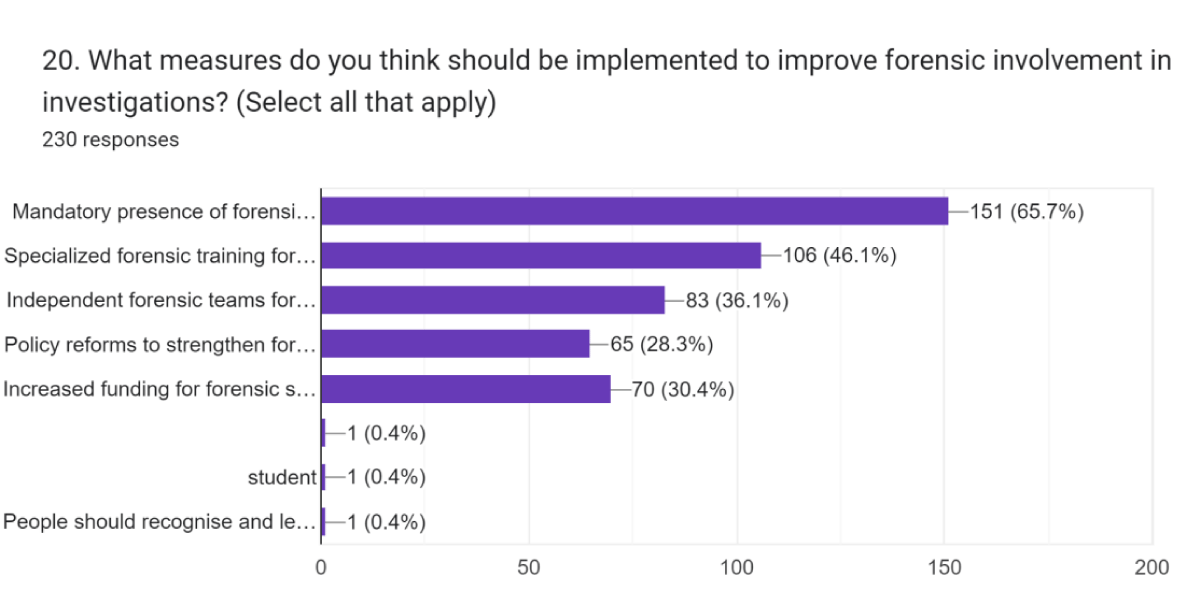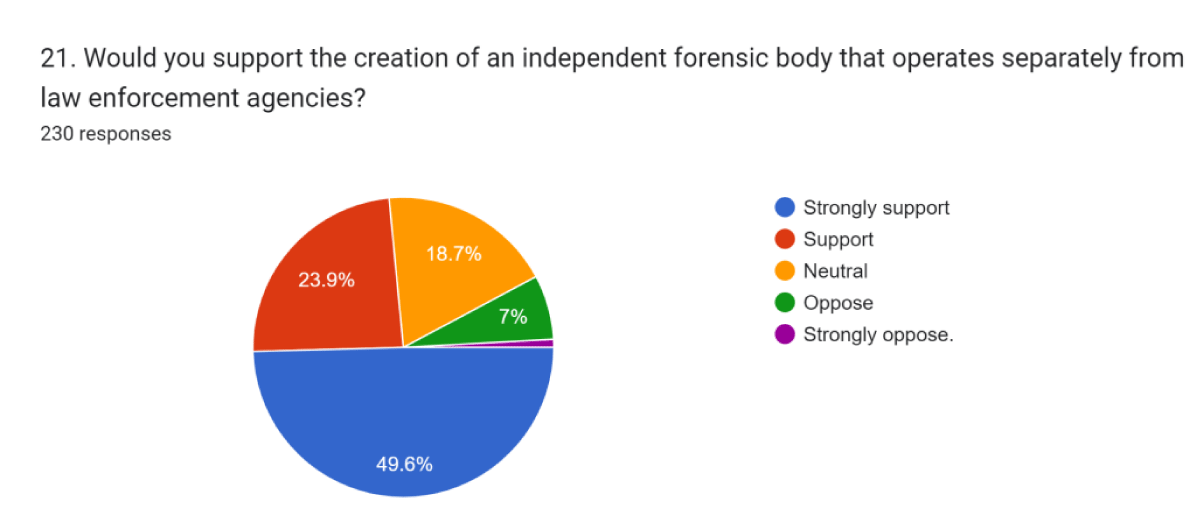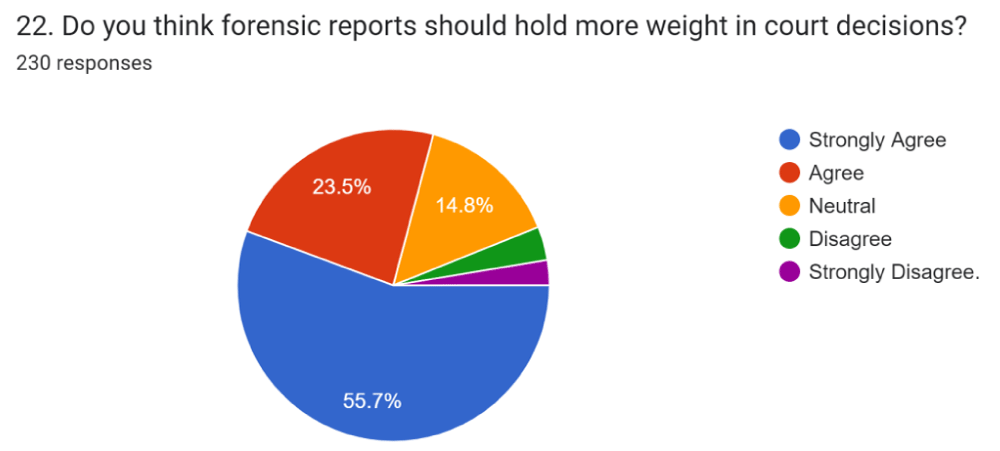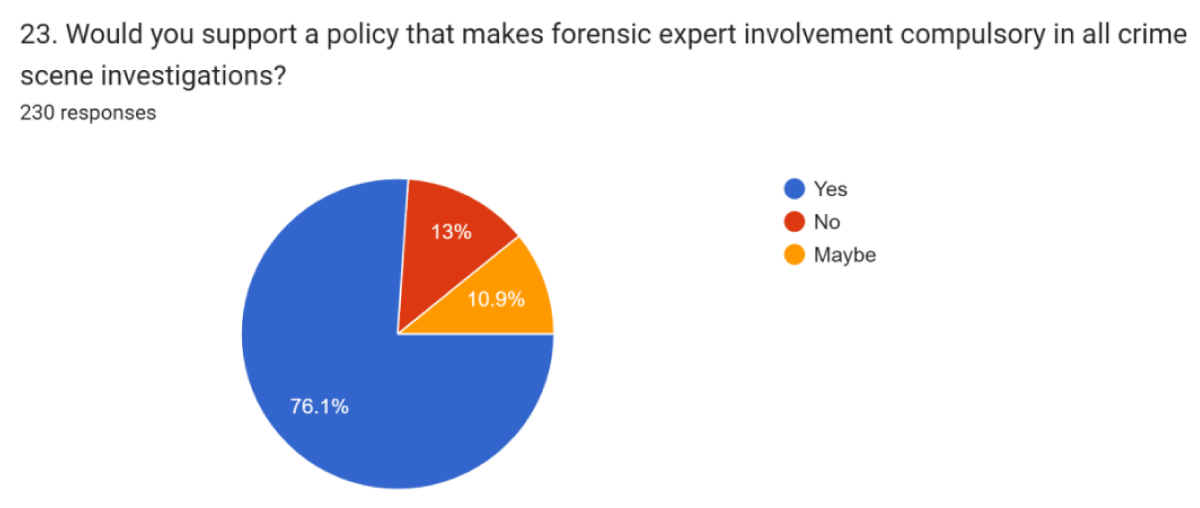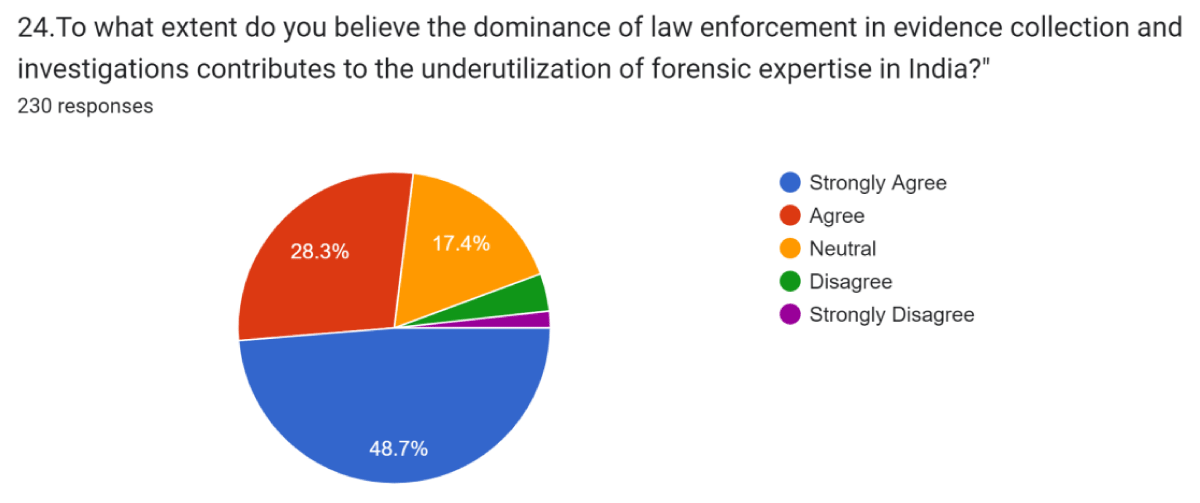More Information
Submitted: May 13, 2025 | Approved: May 21, 2025 | Published: May 22, 2025
How to cite this article: Kanishga I, Bhargava HR. Survey on the Underutilization of Forensic Expertise in India: Examining the Dominance of Law Enforcement in Evidence Collection and Investigations. J Forensic Sci Res. 2025; 9(1): 067-086. Available from:
https://dx.doi.org/10.29328/journal.jfsr.1001083
DOI: 10.29328/journal.jfsr.1001083
Copyright License: © 2025 Kanishga I, et al. This is an open access article distributed under the Creative Commons Attribution License, which permits unrestricted use, distribution, and reproduction in any medium, provided the original work is properly cited.
Keywords: Underutilization; Investigative procedures; Forensic science
Survey on the Underutilization of Forensic Expertise in India: Examining the Dominance of Law Enforcement in Evidence Collection and Investigations
I Kanishga1* and HR Bhargava2
1M.Sc, Forensic Science, Department of Forensic Science, Garden City University, Bangalore, Karnataka, India
2Professor, Department of Forensic Science, Garden City University, Bangalore, Karnataka, India
*Address for Correspondence: I Kanishga, M.Sc, Forensic Science, Department of Forensic Science, Garden City University, Bangalore, Karnataka, India, Email: [email protected]
Forensic science can significantly enhance criminal investigation equity and accuracy. In India, though, forensic experts remain underutilized as case investigations are predominantly performed by law enforcement agencies. This article documents findings of a survey of 230 respondents half of them being forensic experts and other non-forensic respondents like law enforcers exhibiting a wide perceptual gap. While forensic experts emphasize the need for independent intervention so that objective outcomes would be achieved, police respondents strongly favor conventional investigation methods. Systemic barriers like training constraints, availability limitations, and formalization of processes also discourage effective integration of forensic science. The research highlights efforts at policy reform that accord forensic experts a more active role, thereby strengthening the credibility and objectivity of India’s justice system.
Aim of the study
To critically examine the underutilization of forensic expertise in India and investigate how the dominance of law enforcement in evidence collection and criminal investigations affects the integrity and efficacy of the criminal justice system.
The discipline of forensic science has established itself as a fundamental element of contemporary worldwide criminal justice systems. The discipline links scientific methods with legal procedures by providing unbiased evidence that supports both investigation accuracy and trial fairness and judicial fairness. Forensic science delivers substantial contributions to criminal justice through its various disciplines including DNA analysis and toxicology and ballistics and digital forensics and crime scene reconstruction which help both establish guilt and prove innocence. The implementation of forensic expertise during initial investigation stages in India shows inconsistent and inadequate usage. The insufficient use of forensic expertise creates major obstacles for the criminal justice process to achieve efficiency and maintain integrity and fairness.
India's criminal justice system, shaped by its colonial past and often hindered by institutional inertia, still leans heavily on traditional law enforcement methods. While there’s a growing recognition of scientific approaches within legal frameworks and an increasing number of forensic science institutions, the actual use of these methods in everyday investigations is still quite limited. Police officers, who are usually the first on the scene, play a major role in gathering evidence and building cases. However, their critical work is often done without the guidance or input of forensic experts, which can lead to issues with the quality and reliability of the evidence collected.
The fallout from this imbalance is serious. Poorly handled evidence, contaminated crime scenes, improper chain-of-custody practices, and insufficient documentation can all jeopardize cases before they even make it to court. Moreover, the lack of forensic science usage stifles the development of a scientific mindset in both investigative and judicial processes. Relying too much on oral testimonies, confessions, and circumstantial evidence increases the risk of wrongful convictions. Thus, grasping the underlying reasons and consequences of the underutilization of forensic science is not just an academic issue; it’s a crucial need for meaningful reform in the system.
In the Indian criminal justice system, forensic science plays a crucial yet largely untapped role in delivering justice. Even with remarkable strides in forensic technology and techniques, the investigative process is still mainly driven by law enforcement agencies. This often means that forensic expertise is not fully utilized during key moments like evidence collection and crime scene analysis. Such a heavy reliance on police can undermine the scientific integrity of investigations, potentially resulting in gaps, wrongful convictions, or delays in justice.
On a global scale, forensic science is essential for maintaining objectivity and precision in criminal investigations. However, in India, several systemic issues—like a shortage of forensic professionals, inadequate training for law enforcement, limited resources, and bureaucratic hurdles—further marginalize the role of forensic science. This research survey aims to delve into how underutilized forensic science is and how police authorities dominate the handling of forensic evidence. It will also look into the perspectives of various stakeholders and seek ways to enhance the integration of forensic science within the investigative process.
Background and context
Forensic science is a vital component of today’s criminal justice system. It injects scientific rigor, objectivity, and accuracy into criminal investigations, ensuring that evidence gathered from crime scenes is analyzed using proven methods. Worldwide, forensic experts are key players in solving crimes—examining physical evidence, piecing together events, and offering expert testimony in court. Yet, in India, the forensic landscape remains significantly underused and often overshadowed by the dominant role of law enforcement, especially the police, in managing crime scenes and collecting evidence.
The framework for criminal investigations in India is largely centered on the police. While law enforcement is crucial for ensuring public safety and maintaining order, their dominant role in the early stages of investigations often pushes aside the critical input from forensic experts. Police officers are typically the first to arrive at crime scenes, responsible for gathering and securing evidence. While this approach is convenient in practice, it can lead to issues, especially since many police personnel lack proper forensic training. As a result, there's a heightened risk of evidence being contaminated, poorly documented, or misinterpreted, which ultimately undermines the integrity of investigations and the pursuit of justice.
Despite several notable cases in India where forensic science has played a key role—like the Aarushi Talwar case, the Sheena Bora murder, and the Nirbhaya gang-rape investigation—systemic challenges continue to exist. These challenges include a lack of adequate forensic infrastructure, understaffed labs, and delays in processing evidence, poor collaboration between agencies, and a general lack of awareness among law enforcement about the importance and capabilities of forensic science. Often, forensic input is only sought reactively, rather than being integrated into the investigative process from the outset. This reactive approach misses out on the full potential of forensic techniques to identify suspects, establish timelines, or support witness statements.
This study is all about understanding the real impact of the imbalance in forensic practice. By surveying 230 people—half from forensic backgrounds and half from various non-forensic fields like law enforcement, legal practice, and academia—the research aims to create a solid, data-driven picture of how people perceive forensic work in India, the challenges they face, and their suggestions for improvement. It also looks at how this situation affects the credibility of investigations, the admissibility of evidence, and the overall quest for justice.
What makes this research particularly important is its interdisciplinary approach. It not only amplifies the voices of the forensic community, which often gets overlooked in larger policy discussions, but also sheds light on the perspectives of those who are key players in law enforcement and the legal system. By comparing these viewpoints, the study offers a deeper understanding of how different stakeholders perceive the role of forensic science and highlights where they agree or disagree on its application.
Ethical considerations
- Informed consent: Participants were informed about the purpose of the survey, that their participation is completely voluntary, and that their responses will be kept confidential.
- Anonymity and confidentiality: We don’t collect any personally identifiable information. Instead, we aggregate the data for analysis and reporting.
- Data use: All the data we gather is strictly for academic research purposes, ensuring we stick to ethical standards.
Scope of the study
This survey looks into why forensic expertise isn’t being fully utilized in India, focusing on how law enforcement tends to dominate the evidence collection and criminal investigation processes. We conducted the study across various regions in India, gathering insights from 230 participants—115 forensic professionals and 115 non-forensic stakeholders, including police officers, legal experts, academics, and informed citizens. The study aims to understand participant perceptions, awareness, and the practical challenges they face regarding forensic involvement in investigations. Using a structured questionnaire that combines both quantitative and qualitative elements, we dive into important themes like the limited role of forensic experts during the initial crime scene processing, how well law enforcement is trained in forensic procedures, and the level of collaboration between police and forensic teams. The findings aim to pinpoint gaps, systemic barriers, and institutional practices that prevent effective integration of forensic science into the justice system. While the study relies on self-reported data and a specific sample size, it offers valuable insights that can guide future policy reforms, capacity-building initiatives, and strategies for interdisciplinary collaboration. Ultimately, the results are meant to promote a more balanced, scientific, and transparent approach to criminal investigations in India.
Objectives
- To understand the key reasons why forensic expertise isn’t fully utilized in criminal investigations across India.
- To develop practical solutions to better integrate forensic science into investigative procedures.
- To Evaluate how the limited use of forensic evidence affects court decisions and overall judicial fairness.
- To raise public awareness about the importance of forensic science and its collaboration with law enforcement to strengthen the justice system.
Ultimately, the review of literature helps justify the need for the present study, showing that while the importance of forensic science is widely acknowledged, its practical implementation remains inconsistent, particularly in developing regions like India where law enforcement retains primary control over crime scene management. By identifying what is already known and what remains unclear or underexplored, the literature review lays the foundation for new research, helping to refine the research question, choose the appropriate methodology, and position the current work within the broader academic and professional discourse.
The role of forensic science in strengthening the criminal justice system has been widely recognized in global academic and policy literature, yet its integration in many jurisdictions, including India, remains inconsistent and underdeveloped. Scholars such as Sharma [1] and Raghavan [2] have highlighted that forensic science, though critical for objective evidence evaluation, is often sidelined due to investigative dominance by law enforcement agencies. Studies by Gupta and Malhotra [3] have revealed significant gaps in police training on forensic protocols, which often leads to compromised evidence collection and weakens legal outcomes. International research, including reports from the UN Office on Drugs and Crime (UNODC), emphasizes the importance of a multidisciplinary investigative approach and calls for standardized protocols to ensure scientific handling of crime scenes.
In the Indian context, reports by the National Crime Records Bureau (NCRB) and Bureau of Police Research and Development (BPRD) consistently show a low rate of forensic involvement in case investigations, despite the availability of regional forensic science laboratories (FSLs). Empirical analyses by Deshmukh and Khan [4] further underscore the disconnects between forensic potential and its practical application, attributing this to bureaucratic inertia, lack of inter-agency coordination, and limited awareness among judicial officers.
Moreover, literature exploring the perceptions of forensic professionals indicates widespread frustration over delayed referrals, insufficient access to crime scenes, and limited influence during case prosecution. This body of work forms the conceptual foundation for the present study, which aims to empirically assess the perceptions of both forensic and non-forensic professionals regarding the dominance of law enforcement and the underutilization of forensic expertise in India.
Exploring the role of forensic science in Indian criminal justice system [5]: Forensic science includes a range of scientific fields such as DNA analysis, fingerprint analysis, ballistics, toxicology, and digital forensics, among others. These fields are essential for crime scene investigations, evidence collection, analysis, and courtroom presentations. Recently, there has been an increasing acknowledgment of the significance of forensic science within the Indian Criminal Justice System (CJS). It is vital to the CJS as it provides scientific evidence that assists in the investigation and resolution of criminal cases. However, the implementation of forensic science in the Indian criminal justice system encounters numerous challenges that impact the quality and dependability of forensic evidence. These challenges consist of outdated forensic infrastructure, insufficient standardization and accreditation of forensic laboratories, a lack of comprehensive training programs for law enforcement officials, and the absence of clear protocols for the collection, preservation, and analysis of forensic evidence. Such issues can result in evidence mishandling, contamination, and unreliable outcomes, potentially jeopardizing the results of criminal cases and leading to wrongful convictions. Addressing these challenges can improve the quality and trustworthiness of forensic evidence, fortify the Indian criminal justice system, and ensure that justice is delivered fairly and reliably. Therefore, it is imperative to assess and enhance the application of forensic science within the Indian criminal justice system to guarantee its robustness, reliability, and compliance with international best practices. This research paper intends to examine various domains of forensic science, the existing legal framework, and relevant judicial precedents in the Indian criminal justice system, while identifying challenges and proposing recommendations for further enhancement.
Forensic evidence in Indian courts [6]: Analyzing the role of investigating agencies in justice delivery: This research paper investigates the essential function of forensic evidence within the Indian legal framework, emphasizing its importance in bolstering the integrity of criminal investigations and judicial proceedings. It reviews the historical development of forensic science in India, outlining various forms of forensic evidence such as DNA testing, fingerprint analysis, and digital forensics. The paper assesses the crucial role of investigative agencies in the collection and presentation of forensic evidence, while also discussing the obstacles they encounter, including limited resources, lack of standardization, and inadequate training. Furthermore, it examines the legal structures that regulate forensic evidence, particularly the Indian Evidence Act and the Code of Criminal Procedure, highlighting the necessity for reforms to align with advancements in forensic techniques. Through case studies like the Aarushi Talwar and Jessica Lal murder cases, the paper demonstrates the complexities and ramifications of forensic evidence in practical situations. The research concludes with suggestions for enhancement, advocating for standardized procedures, improved training, interagency cooperation, and the creation of independent forensic review bodies. In summary, this paper emphasizes the critical need for a strong forensic system to ensure justice and protect individual rights within the Indian legal landscape.
Forensic evidence and its use in Nigerian criminal investigations: The main objective of the upcoming study is to identify an individual by evaluating the evidence and facts related to a crime or disaster. This process relies heavily on the precise interpretation of facts, the reconstruction, and comprehension of the chronological order of events, rendering each piece of evidence a vital component of information. In numerous nations, including India, forensic medical and dental assessments at crime scenes are performed by law enforcement personnel, as medical and dental specialists are rarely the initial responders.
Doctrinal analysis of the evolution of forensic evidence in the Indian criminal justice system: Currently, the field of science is advancing rapidly, with forensic science—utilizing scientific techniques to deliver impartial circumstantial evidence—playing a significant role in this progress. Consequently, the volume of scientific data is increasing, yet it is becoming increasingly intricate and often less accurate and accessible to those without a scientific background. Over the past two to three decades, notable advancements have occurred in forensic science, including DNA profiling, the establishment of physical evidence databases, and the development of related scientific tools. However, due to insufficient funding, forensic methods are infrequently employed in criminal investigations. While there have been numerous specialized analyses regarding the costs and benefits of DNA testing for resolving cold cases and property crimes, a comprehensive examination of the entire spectrum of physical evidence and case management within the criminal justice system remains absent. The analysis of evidence can assist law enforcement in understanding the initial commission of a crime. This research paper aims to explore the application of forensic science in criminal investigations and trials, as well as how the Indian judiciary has recognized forensic science-based evidence in legal cases and how these practices can be enhanced in the future.
Through crime scenes to laboratories, how forensic evidence is utilized and misplaced throughout the criminal justice system [7]: The primary aim of the forthcoming investigation is to determine the identity of an individual through the assessment of evidence and facts associated with a crime or disaster. This entire process hinges on the accurate interpretation of facts, the reconstruction, and understanding of the sequence of events, making each piece of evidence a crucial element of information. In many countries, including India, forensic medical and dental evaluations at crime scenes are conducted by police officials, as medical and dental experts are seldom the first responders.
Unanalyzed evidence in law-enforcement agencies [8]: A national examination of forensic processing in police departments: This research examined the processing of forensic evidence within a nationally representative sample of state and local law enforcement agencies (n = 3,153). Over a span of five years, these agencies indicated that 14% of all unresolved homicide cases (approximately 3,975 cases) and 18% of all unresolved rape cases (around 27,595 cases) included forensic evidence that had not been forwarded to a forensic crime laboratory for examination. It was noted that nearly 40% of these unexamined homicide and rape cases were reported to have DNA evidence. The predominant reason cited for the failure to submit forensic evidence for analysis was the absence of a suspect in the case.
An efficacy of forensic technology in crime investigation and administration of justice Narco analysis and DNA mapping [9]: Over the past twenty-five years, there have been notable advancements in forensic sciences, including narco analysis, DNA mapping, polygraph testing, brain mapping, and the development of new scientific instruments. Nevertheless, further research is necessary to evaluate the impact of these advancements on the significance and role of scientific evidence in the processing and prosecution of criminal cases. While new forensic technologies have been the subject of focused research, comprehensive studies assessing the full range of scientific evidence available at crime scenes and its effective investigation and application in the justice system are lacking. Both the legal system and law enforcement agencies are increasingly relying on forensic science to aid in crime investigations and secure convictions. However, within the context of the Indian judiciary, the practical benefits of forensic science have yet to be established in relation to the labor involved and the outcomes of cases. Research in this domain has predominantly focused on scientific and technological aspects rather than on how individuals can effectively utilize forensic services and science to achieve satisfactory justice outcomes. The findings presented are the result of an extensive investigation conducted by the researcher. This document provides an overview of the rationale and objectives of the research project, along with a description of the current status of the project’s work. Given the critical role of forensic evidence in investigations and court proceedings, service providers could gain from a better understanding of its application and interpretation. The results of this study may enhance the effective utilization of forensic evidence. The inadequate application of forensic science within the criminal justice system is impeded by a lack of empirical research on the effectiveness of various types of forensic evidence.
An overview of the digital forensic investigation infrastructure of India [10]: The 2008 Mumbai terror attacks highlighted the necessity for India to enhance its preparedness in responding to digital intelligence and to improve the effectiveness of post-incident investigations. This paper examines the digital forensic investigation framework in India, focusing on judicial statutes, law enforcement structures, and academic institutions. The findings indicate that while there has been progress in establishing guidelines for digital forensic investigations, these do not hold the same authority as the NIST or ACPO guidelines in the UK and US. Additionally, there is potential for increased international collaboration in addressing borderless cybercrimes, as well as opportunities for private companies to offer independent investigative and training services to law enforcement agencies. Moreover, there exists a chance for academic institutions in the US and UK to forge collaborative partnerships with higher education institutions in India to enhance and develop the field of digital forensic investigation.
Forensic science in justice in India [11]: Forensic science is essential in ensuring justice, especially in criminal investigations and identifying offenders. This paper examines the evolution and application of forensic science within the Indian legal framework and its recognition by Indian judiciary. The research intends to evaluate the rulings of India's higher courts over the last ten years that have utilized forensic science as a form of evidence. It also investigates the Indian judiciary's position on the admissibility of forensic evidence, contrasting it with the views of international courts. Furthermore, the paper identifies the deficiencies in Indian criminal legislation and advocates for a more effective incorporation of forensic evidence. A comparative analysis of the admissibility standards for forensic evidence in the United States, the United Kingdom, and Germany is also included. The significance of circumstantial and forensic evidence is highlighted, particularly in their capacity to establish or refute cases beyond a reasonable doubt. Lastly, the paper addresses the role of forensic toxicology and chemical analysis in India's judicial processes, underscoring the importance of toxicological assessments in cases of poisoning.
Utilization of forensic odontologic findings in solving the unsolved cases, A retrospective study [12]: Forensic dentistry, also known as dental jurisprudence, refers to the integration of dental sciences within the legal framework. This field encompasses various areas such as individual and mass identification, along with bite mark analysis. The significance of forensic odontology has notably increased in Western nations, where it is regarded as a credible form of evidence in criminal investigations. In light of the rising crime rates in India, reported by the National Crime Records Bureau at an annual increase of over 6.4%, there has been a growing number of studies evaluating the role of forensic odontological evidence in resolving criminal cases within the country. A retrospective analysis was conducted in Puducherry and Tamil Nadu in December 2018, utilizing a well-structured, pre-tested format adapted from a previous study by Senthil et al. in 2012. Following a thorough explanation of the study's purpose, consent was secured from the Directors of the forensic sciences departments in both Puducherry and Tamil Nadu. Secondary data concerning the application of forensic odontological evidence in criminal investigations were gathered from 2,987 cases. This data was subsequently organized using Microsoft Excel, and descriptive statistics were analyzed with SPSS software (version 20). The results indicated that only three cases were resolved through forensic odontology findings, which relied solely on antemortem and post-mortem reports. The timeframe for the data collection spanned 1 to 3 years post-investigation, with the victims' dentists identified through their relatives. The findings of this study highlight a significant underutilization of forensic odontological evidence in criminal case investigations.
The unrealized error-reduction promise of forensic science [13]: An Empirical Study of its Production and Use: Forensic science, in theory, offers objective and impartial evidence in criminal justice proceedings that are often influenced by emotions, cognitive biases, and the limitations of human memory. By maintaining theoretical objectivity and independence from other participants and processes within the criminal justice system, forensic science has the capacity to enhance the reliability of the criminal process, thereby decreasing the incidence of wrongful convictions and unresolved crimes. However, what is the practical application of this theory? The significant role of forensic science in numerous wrongful convictions warrants a cautious approach. To gain a clearer understanding of the actual impact of forensic science, we gathered data regarding the prevalence and application of forensic evidence across five jurisdictions at various stages of the criminal process. Additionally, we examined existing data on crime laboratories and conducted an experimental survey targeting prosecutors and criminal defense attorneys to assess the influence of forensic evidence on the plea-bargaining process. Our results are concerning. Forensic evidence is still analyzed in only a small percentage of cases where it is applicable. Although it is frequently utilized in homicide cases, its application is severely restricted by resource limitations, leading to prolonged turnaround times for less serious offenses, which prompts law enforcement and prosecutors to depend on alternative forms of evidence. When forensic evidence is employed, it is often tested late in the criminal process, sometimes merely to satisfy juror expectations. While this response to limited forensic resources is understandable, the delayed timing may contribute to unresolved crimes and create pressure to align with preexisting guilt theories. Despite the theoretical promise of forensic science to enhance the reliability of the criminal process, its actual implementation undermines many of its potential benefits.
An insight into the awareness and utilization of "dental evidence" among the police force in Punjab [14]: The primary aim of the forthcoming investigation is to determine the identity of an individual through the assessment of evidence and facts associated with a crime or disaster. This entire process hinges on the accurate interpretation of facts, the reconstruction, and understanding of the sequence of events, making each piece of evidence a crucial element of information. In many countries, including India, forensic medical and dental evaluations at crime scenes are conducted by police officials, as medical and dental experts are seldom the first responders.
Sexual violence perpetrated against women in India: the role of forensic evidence [15]: The primary aim of the forthcoming investigation is to determine the identity of an individual through the assessment of evidence and facts associated with a crime or disaster. This entire process hinges on the accurate interpretation of facts, the reconstruction, and understanding of the sequence of events, making each piece of evidence a crucial element of information. In many countries, including India, forensic medical and dental evaluations at crime scenes are conducted by police officials, as medical and dental experts are seldom the first responders.
The impact of forensic evidence on the criminal justice system in India [16]: an examination of opportunities, challenges, and future directions: the application of forensic evidence in criminal investigations and trials has attracted considerable attention in recent years, with a growing dependence on such evidence within legal proceedings. Forensic evidence can provide substantial advantages to the criminal justice system, including the enhancement of evidence quality, aiding in the identification of offenders, and clearing the innocent. Nevertheless, the use of forensic evidence also introduces various challenges, encompassing technical, legal, institutional, and cultural obstacles. This research paper investigates the influence of forensic evidence on the criminal justice system in India, examining both opportunities and challenges, as well as future prospects. The study employs a mixed-methods approach, incorporating interviews with field experts, an analysis of legal frameworks, and a review of existing literature. The findings reveal significant opportunities for the integration of forensic evidence in India's criminal justice system, such as the potential to elevate evidence quality, boost conviction rates, and foster public confidence in the justice system. Concurrently, the study underscores challenges like the necessity for standardization of forensic practices, expert training, and resource limitations. The paper concludes with suggestions for policymakers, practitioners, and researchers aimed at improving the utilization of forensic evidence within India's criminal justice framework.
An empirical analysis of police perceptions about role of forensic science in crime investigation [17]: The aim of the current research was to assess the significance of forensic science from the perspective of law enforcement officials, specifically police officers. The study focused on police personnel engaged in crime investigations in Nagpur, Maharashtra, India, who were chosen as the sample group. Data was gathered through personal visits to randomly selected police stations, where questionnaires were distributed to the investigating officers. A total of 152 participants provided data, which was subsequently analyzed. The findings revealed that nearly all investigating officers recognized the importance of forensic science and its application in crime investigation. Additionally, the participants concurred that effective crime scene management is crucial to the investigative process.
Integrating science and law [18]: A Forensic Justice Perspective: Forensic justice provides a novel perspective that integrates forensic science with the legal system, enhancing the examination and interpretation of evidence while bolstering the reliability and efficacy of legal proceedings. It aligns with fundamental principles of equality and the Law of Evidence, necessitating strict compliance with regulations and fostering accountability within the criminal justice framework. In India, forensic science is pivotal in post-crime investigations, involving meticulous evidence collection and analysis at crime scenes, which aids law enforcement in building robust cases based on scientific data. However, the application of forensics in investigations faces numerous challenges, the most prominent being the ambiguous standards for the admissibility of forensic evidence in court. The Allahabad High Court, in the case of Titli v. Alfred Robert John, established criteria for the acceptance of expert evidence, underscoring its significance and reliability. The Supreme Court of India outlined eight criteria for admissibility, yet ambiguity remains regarding their implementation. Forensic intelligence is essential in crime prevention and prediction, employing pattern recognition and criminal profiling techniques. In many regions, including India, forensic justice has not yet realized its full potential in preventing, investigating, and prosecuting crimes. This article aims to underscore the inadequate application of forensic science in post-crime investigations and the lack of forensic intelligence in preemptive crime prevention efforts. It focuses on the integration of forensic science into criminal investigations, assessing its practical application and proposing reforms to address the challenges faced by law enforcement and the judiciary. This article explores how forensic justice can revolutionize the Indian legal system by embedding forensic practices into both pre- and post-crime policies.
Use of forensic evidence by the police and courts [19]: Forensic laboratories serve a crucial function in the prosecution process within our criminal justice system. However, how often is forensic evidence utilized during charging, plea negotiations, trials, and sentencing? Is it true that forensic science is 'overburdened and underutilized,' as some experts have proposed.
Importance of crime scene visits by a forensic medicine expert [20]: A Survey-Based Study: This research aims to evaluate the Indian inquest system, which is carried out by individuals without scientific training, such as police officers and magistrates—who are not necessarily qualified in either science or law—against the medical examiner system in the United States, which is performed by physicians specializing in forensic medicine and pathology.
Forensic science and its limitations in rape and murder cases in India [21]: Forensic science is crucial in analyzing crime scenes and collecting various forms of evidence, such as clothing, cigarette butts, blood, semen, and hair, to scientifically determine the guilt of the accused. In cases of rape and murder, DNA testing is employed to verify the identity of the victim, providing critical evidence that aids in the swift investigation and resolution of trials. However, forensic science is not infallible and has its limitations. Therefore, first responders, including the Crime Laboratory Ultimate Evidence System team and forensic specialists, must be aware of these limitations during the collection and examination of samples; otherwise, it may result in erroneous outcomes. Such inaccuracies can arise from inadequate sample size, improper collection techniques, or delays in examination. It is strongly advised to adhere to standard operating procedure guidelines, as failure to do so jeopardizes the admissibility of forensic evidence needed to establish guilt beyond a reasonable doubt. Consequently, the court may acquit the accused, granting them the benefit of the doubt. This article examines the relevance and constraints of forensic science within the Indian Criminal Justice System and emphasizes the necessity of following proper protocols to achieve reliable results.
The status of forensic medicine in India [22]: The curriculum in Indian medical colleges has struggled to fulfill the aforementioned objectives, as demonstrated by a study conducted among undergraduates at the Bangalore Medical College and Research Institute, as well as among physicians in both private and government sectors in Karnataka. A significant number of undergraduates and practicing doctors exhibit a lack of confidence in performing routine medicolegal responsibilities. Additionally, the judiciary and law enforcement frequently identify deficiencies in the certificates provided by medical professionals. It is important to highlight that, in India, unlike in developed nations, the majority of medico-legal tasks are carried out by government medical officers who lack postgraduate qualifications in forensic medicine. Therefore, it is increasingly essential to provide undergraduates with a more comprehensive training approach to ensure they can conduct high-quality medico-legal work, which is crucial for the administration of justice.
Critical analysis of admissibility of forensic evidence and reports in the criminal justice system of India [23]: The necessity of employing scientific methods in investigations is paramount for the collection of evidence. It is crucial to ensure that evidence is gathered and preserved without contamination or alteration, and that it is packaged and transported to the laboratory in a scientific and secure manner. This presents a significant challenge for investigative agencies, which utilize advanced techniques to extract evidence that can link it to the crime scene and ultimately identify the perpetrator, ensuring they are brought to justice. Despite the heightened focus on forensic evidence in the last decade, there is limited empirical data available that outlines the types of evidence typically collected and the degree to which this evidence is submitted to and analyzed by forensic crime laboratories. Furthermore, there is a scarcity of research detailing the influence and significance of such evidence on criminal justice outcomes. Although the current study indicates that forensic evidence can impact case processing decisions, this influence is not consistent across all types of crimes and evidence; the effects of evidence differ based on the nature of the criminal offense, the variety of forensic evidence, the level of criminal decision-making, and other case-specific characteristics.
Effect of forensic evidence on criminal justice case processing [24]: This research investigated the influence and significance of forensic evidence on the outcomes of case processing within a sample of 4,205 criminal cases sourced from five jurisdictions in the United States. The regression analyses revealed that forensic evidence consistently and significantly affected case-processing decisions. However, the impact of forensic evidence varied depending on the timing and nature of the examination: the gathering of crime scene evidence was indicative of arrests, while the analysis of such evidence was associated with the referral for charges, the filing of charges, trial convictions, and the length of sentences. The sole decision outcome where forensic evidence did not generally exert an influence was in relation to guilty plea negotiations. Further research is necessary to explore the filtering of forensic evidence across various crime categories, from the crime scene to its application by investigators, prosecutors, and adjudicators, as well as to identify the factors that influence decisions regarding the collection of evidence, its submission to laboratories, and the request for examinations.
Forensic evidence and the police: The Effects of Scientific Evidence on Criminal Investigations, Final Report: The objectives of this project are to outline the various applications of physical evidence in criminal investigations and to evaluate the impact of scientifically analyzed evidence on solving serious crimes, as well as on the apprehension and prosecution of offenders. The lack of empirical research in this field, combined with the rapid expansion of crime laboratories in the last decade, renders this a particularly relevant and significant area of study. Data has been gathered from approximately 2,700 randomly selected case investigations from police and laboratory records across four jurisdictions. The study's findings indicate that the clearance rates for robberies and burglaries are notably higher in cases where physical evidence is analyzed compared to those where it is not. Forensic evidence proves to be most influential in cases that typically have the lowest resolution rates—specifically, cases involving suspects who are neither in custody nor identified at the beginning of the investigation. Furthermore, a considerably higher proportion of individuals arrested for burglary and robbery are convicted in cases that include forensic evidence. The influence of scientific evidence on the clearance and prosecution of aggravated assault cases is less significant and, in many instances, does not differ markedly from cases lacking forensic evidence. Several recommendations are provided, primarily targeting patrol, detective, crime scene, and crime laboratory operations. These recommendations, along with suggestions for future research, aim to direct limited police and scientific resources toward investigations where physical evidence can have the most substantial impact.
Forensic evidence and the police: The effects of scientific evidence on criminal investigations: The objectives of this project are to outline the various applications of physical evidence in criminal investigations and to evaluate the impact of scientifically analyzed evidence on solving serious crimes, as well as on the apprehension and prosecution of offenders. The lack of empirical research in this field, combined with the rapid expansion of crime laboratories in the last decade, renders this a particularly relevant and significant area of study. Data has been gathered from approximately 2,700 randomly selected case investigations from police and laboratory records across four jurisdictions. The study's findings indicate that the clearance rates for robberies and burglaries are notably higher in cases where physical evidence is analyzed compared to those where it is not. Forensic evidence proves to be most influential in cases that typically have the lowest resolution rates—specifically, cases involving suspects who are neither in custody nor identified at the beginning of the investigation. Furthermore, a considerably higher proportion of individuals arrested for burglary and robbery are convicted in cases that include forensic evidence. The influence of scientific evidence on the clearance and prosecution of aggravated assault cases is less significant and, in many instances, does not differ markedly from cases lacking forensic evidence. Several recommendations are provided, primarily targeting patrol, detective, crime scene, and crime laboratory operations. These recommendations, along with suggestions for future research, aim to direct limited police and scientific resources toward investigations where physical evidence can have the most substantial impact.
Forensic scientific evidence [25]: problems and pitfalls in India: Forensic science, a branch of science, has significantly altered the landscape of criminal adjudication, particularly the trial process. Its contribution to the judiciary in resolving matters beyond the judges' expertise is undeniable. However, forensic scientists and legal stakeholders are currently facing substantial criticism regarding the reliability of forensic evidence and the legal community's ability to evaluate it. Numerous issues and challenges undermine the credibility of forensic science, beginning at the initial crime scene investigation and persisting through the trial phase. A key concern within the legal framework is the disparity between the scientific and legal communities regarding their areas of interaction. It is imperative to identify and address these fundamental issues to prevent serious miscarriages of justice.
Digital evidence barriers overcoming in the Ukrainian case [26]: New Actors and Standards: Addressing Digital Evidence Challenges in the Ukrainian Context: Emerging Stakeholders and Standards that Illuminate the Practical Hurdles Faced. It also features case studies where Civil Society Organizations (CSOs) have stepped in when governmental bodies have been unable to adequately investigate significant international crimes, demonstrating how these entities aid in the modernization of investigative processes through technology. As digital technology increasingly plays a pivotal role in criminal activities, law enforcement agencies are compelled to evolve their investigative strategies to navigate this new digital environment. This article proposes avenues for collaboration between public institutions and law enforcement bodies, underscoring the necessity of interdisciplinary cooperation to keep up with the advancements in the digital criminal sphere. The article employs a blend of general scientific and specialized methodologies. The findings underscore the critical need for ongoing innovation, interdisciplinary collaboration, and policy advancement to establish improved frameworks and partnerships.
Verifiable limited disclosure: Reporting and handling digital evidence in police investigations [27]: Investigations conducted by law enforcement that involve digital evidence primarily concentrate on the forensic analysis of storage devices found in personal electronic gadgets such as laptops and smartphones. Nevertheless, several factors are rendering digital forensic tools less effective: (i) the storage capacities of electronic devices have expanded, along with the volume of personal data stored on them; (ii) an increasing number of cybercrimes are perpetrated via social media, where evidence may reside on these platforms rather than on personal devices; (iii) there is a heightened necessity to safeguard digital privacy, particularly when scrutinizing digital evidence from witnesses and victims of cyber offenses. These elements present various practical challenges for both law enforcement agencies and the public in terms of revealing and managing digital evidence. This paper delineates and exemplifies the primary challenges and introduces the notion of verifiable limited disclosure, which establishes a communication protocol aimed at ensuring the privacy, continuity, and integrity of digital evidence. Specifically, the protocol enables (i) individuals to determine which evidence to share with law enforcement and (ii) either party to demonstrate any alterations made to the disclosed evidence. The paper also explores strategies for executing the communication protocol utilizing standard security and privacy tools and outlines a framework for assessing their efficacy.
An efficacy of forensic technology in crime investigation and administration of justice: Narco analysis and DNA mapping [28]: Over the past twenty-five years, there have been notable advancements in forensic sciences, including narco analysis, DNA mapping, polygraph testing, brain mapping, and the development of new scientific instruments. Nevertheless, further research is necessary to evaluate the impact of these advancements on the significance and role of scientific evidence in the processing and prosecution of criminal cases. While new forensic technologies have been the subject of focused research, comprehensive studies assessing the full range of scientific evidence available at crime scenes and its effective investigation and application in the justice system are lacking. Both the legal system and law enforcement agencies are increasingly relying on forensic science to aid in crime investigations and secure convictions. However, within the context of the Indian judiciary, the practical benefits of forensic science have yet to be established in relation to the labor involved and the outcomes of cases. Research in this domain has predominantly focused on scientific and technological aspects rather than on how individuals can effectively utilize forensic services and science to achieve satisfactory justice outcomes. The findings presented are the result of an extensive investigation conducted by the researcher. This document provides an overview of the rationale and objectives of the research project, along with an explanation of its current status. Given the critical role of forensic evidence in investigations and court proceedings, service providers could gain from understanding its application and interpretation. The results of this study may enhance the effective utilization of forensic evidence, addressing the challenges posed by the insufficient empirical research on the efficacy of various types of forensic evidence in the criminal justice system.
The role of forensic evidence in criminal investigations in India [29]: Over the past twenty-five years, there have been notable advancements in forensic sciences, including narco analysis, DNA mapping, polygraph testing, brain mapping, and the development of new scientific instruments. Nevertheless, further research is necessary to evaluate the impact of these advancements on the significance and role of scientific evidence in the processing and prosecution of criminal cases. While new forensic technologies have been the subject of focused research, comprehensive studies assessing the full range of scientific evidence available at crime scenes and its effective investigation and application in the justice system are lacking. Both the legal system and law enforcement agencies are increasingly relying on forensic science to aid in crime investigations and secure convictions. However, within the context of the Indian judiciary, the practical benefits of forensic science have yet to be established in relation to the labor involved and the outcomes of cases. Research in this domain has predominantly focused on scientific and technological aspects rather than on how individuals can effectively utilize forensic services and science to achieve satisfactory justice outcomes. The findings presented are the result of an extensive investigation conducted by the researcher. This document provides an overview of the rationale and objectives of the research project, along with an explanation of its current status. Given the critical role of forensic evidence in investigations and court proceedings, service providers could gain from understanding its application and interpretation. The results of this study may enhance the effective utilization of forensic evidence, addressing the challenges posed by the insufficient empirical research on the efficacy of various types of forensic evidence in the criminal justice system.
DNA evidence [30]: Examining Police Officers’ Knowledge of handling Procedures in a Mid-Size Department: Research on policing is prevalent in criminal justice literature; however, there is a notable scarcity of studies that provide empirical data on how police manage evidence, particularly DNA evidence. This is surprising given the critical role that evidence handling plays in the investigation and prosecution of criminal cases. This paper examines the standards of evidence handling within a mid-sized police department located in the northwestern United States. Findings from three surveys—two targeting officers within the department and one directed at state crime lab managers who analyze evidence samples submitted by local police—indicate that officers in this mid-sized city possess only a moderate understanding of the appropriate procedures for handling evidence, including the collection, packaging, transportation, and submission of potential DNA evidence.
‘You don’t know what you’ve got ‘til it's gone’ [31]: Police retention of investigative materials: The proper seizure, handling, and secure storage of evidence during criminal investigations is essential for the effective detection and prosecution of crimes. Additionally, the secure retention of materials after an investigation concludes, even following a conviction, is vital for the functioning of the appellate system and for the review of 'cold cases.' Despite occasional high-profile cases highlighting failures in maintaining the integrity and retention of evidence, there remains a reluctance to acknowledge lost evidence, particularly when considering the issue in aggregate rather than on a case-by-case basis. This lack of transparency is further exacerbated by a deficit in accountability, allowing the issue to slip through regulatory gaps. This article seeks to uncover instances of lost evidence by examining police retention practices for investigative materials, presenting findings from surveys conducted with lawyers and miscarriage of justice advocates (n = 65) and police personnel (n = 87), along with 21 interviews with current and former police officers. We pinpoint 'weak links' in the evidence chain that require fortification, such as enhanced training, improved physical packaging and storage solutions, adequate training for police personnel, and the establishment of specialized roles for managing 'exhibits.' Beyond practical resource needs, the issue necessitates accessible data to recognize the problem and to develop accountability and oversight mechanisms to ensure proper processes are followed.
Lost and destroyed evidence [32]: The search for a principled approach to abuse of process: This article analyzes the circumstances in which evidence that the police were obligated to collect or preserve, which could have supported the defendant's case during trial, is either lost or destroyed. It specifically addresses the appropriate approach to take when such lost or destroyed evidence is the basis for a motion to stay proceedings due to abuse of process. The ruling in R (on the application of Ebrahim) v Feltham Magistrates’ Court; Mouat v DPP marked a significant development in this area, as it clarified that the two categories of abuse cases—those where the defendant is unable to receive a fair trial (Category 1) and those where it would be unjust for the defendant to stand trial (Category 2)—are analytically separate. Consequently, it follows that a defendant's right to a fair trial may be compromised even in the absence of any malfeasance by the police. However, an analysis of cases following Ebrahim indicates a persistent unfortunate trend similar to that seen in pre-Ebrahim cases, specifically a tendency to cite the lack of bad faith as a reason for not staying proceedings in a Category 1 case. A more principled perspective suggests that the court should primarily focus on the implications of police conduct when assessing whether the defendant can receive a fair trial, and the nature of this conduct should be the central consideration when evaluating whether it would be unjust for the defendant to be tried.
Police investigations [33]: Practice and Malpractice: In an era where the government is intentionally stoking a 'moral panic' regarding crime, the traditional right of suspects to remain silent without facing repercussions is set for elimination, and 'cost-effective' crime control is prioritized by the Home Office, it is becoming increasingly challenging to remember the markedly different climate of concern that prompted the establishment of the Royal Commission on Criminal Justice in 1991. It is crucial to recall that the primary concern at that time was the legitimacy of the entire police and criminal justice system. The repercussions of wrongful convictions had escalated to such an extent that there was considerable discourse surrounding the necessity for significant reforms, including a shift from an adversarial to an inquisitorial justice system, or the implementation of stringent new rules regarding the exclusion and/or corroboration of evidence.
Organizational justice and police misconduct [34]: In an era where the government is intentionally stoking a 'moral panic' regarding crime, the traditional right of suspects to remain silent without facing repercussions is set for elimination, and 'cost-effective' crime control is prioritized by the Home Office, it is becoming increasingly challenging to remember the markedly different climate of concern that prompted the establishment of the Royal Commission on Criminal Justice in 1991. It is crucial to recall that the primary concern at that time was the legitimacy of the entire police and criminal justice system. The repercussions of wrongful convictions had escalated to such an extent that there was considerable discourse surrounding the necessity for significant reforms, including a shift from an adversarial to an inquisitorial justice system, or the implementation of stringent new rules regarding the exclusion and/or corroboration of evidence.
The “near miss” of Liam Allan [35]: Critical problems in police disclosure, investigation culture, and the resourcing of criminal justice: Historically, miscarriages of justice have served as significant triggers for reform. It appears that we only address the most critical issues—often evident to those directly involved in practice—after the harm has occurred. These miscarriages have primarily led to efforts to learn from the abuses and errors made by those in positions of authority. It is rare for a 'near miss'—a situation where a wrongful conviction is narrowly avoided—to gain public attention, much less to shed light on the persistent issues plaguing the criminal justice systems in England and Wales. The case of Liam Allan exemplifies such a 'near miss' and effectively underscores serious, yet previously under-discussed, concerns regarding the early-stage disclosure of evidence by the police within the criminal justice framework. These issues reflect the inherent flaws in the current system, which, without substantial reform, will inevitably result in ongoing injustices for both the accused and victims, squander resources, and erode public trust in the justice system's fairness and efficacy. This article primarily concentrates on Allan's case and explores this matter by focusing on three specific issues: the police's disclosure of evidence and information, the investigative culture—especially concerning sexual offence allegations—and the broader challenge of funding within the criminal justice system.
Research design
- Type: Descriptive and exploratory survey-based study
- Approach: Mixed-method (quantitative and qualitative)
- Data collection: Structured questionnaire administered digitally.
- Data type: Primary data collected from field experts and professionals and non-forensic background.
Materials required:
- Structured questionnaire (digitally)
- Computer with spreadsheet/statistical software (e.g., MS Excel)
- Online survey platform (e.g., Google Forms, SurveyMonkey)
- Consent forms (if required by ethical guidelines in google forms)
- Internet access (for digital responses and follow-ups)
Sampling technique:
- Sampling method: Purposive and stratified sampling.
- Sample size: 230 participants.
- 115 Forensic professionals (from public and private sectors).
- 115 non-forensic respondents (law enforcement personnel, lawyers, academics, etc.).
Sampling criteria:
- Must be professionals with experience in law enforcement, forensic science, criminal justice, or related fields and non-forensic professionals
- Representation from diverse regions/states in India (if possible)
Methods of data collection
Questionnaire survey: A structured questionnaire including both closed-ended and open-ended questions was distributed to participants via email, messaging platforms, and in-person networks.
Format:
- Multiple-choice
- Likert scale
- Yes/No
- Short descriptive answers
Validation: The questionnaire was reviewed by subject matter experts to ensure relevance and clarity.
Procedure:
- Preparation of survey instrument: Drafting of the survey questions aligning with the research objectives.
- Pilot Testing: Conducted with a small group (5–10 participants) to check clarity and functionality.
- Distribution of questionnaire: Shared via email, social media, institutional contacts, and in-person where feasible.
- Data collection period: Responses were collected over a period of 1–2 months to ensure a representative and diverse sample.
- Data compilation and cleaning: Incomplete or irrelevant responses were filtered and cleaned systematically.
Data analysis
- Quantitative data: Analyzed using frequency distributions, percentages, and cross-tabulations.
- Qualitative data: Thematic analysis of open-ended responses to identify recurring patterns or insights.
Ethical considerations
- Participation in the study was voluntary, and informed consent was obtained.
- No personally identifiable information was collected.
- Data confidentiality was maintained.
Questionnaires?
Section 1: Demographic Information
Section 2: Involvement of Forensic Experts in Investigations
- How often are forensic experts called to crime scenes for evidence collection?
- When forensic experts are involved, at what stage of the investigation are they usually called?
- Who primarily leads crime scene investigations in India?
- Have you ever encountered cases where law enforcement handled forensic evidence without expert involvement?
- In your experience, how often does law enforcement properly handle forensic evidence?
- Do you think forensic experts should have more authority in crime scene management?
Section 3: Challenges Faced by Forensic Experts
- What are the biggest challenges you face in asserting your role in crime scene management? (Select all that apply)
- How often do law enforcement officers override forensic recommendations in investigations?
- Have you witnessed or heard of cases where forensic evidence was ignored or misinterpreted due to police dominance?
- . Do you think law enforcement officers receive adequate forensic training?
- Do you believe forensic evidence is undervalued in court due to improper collection and handling
Section 4: Impact on Forensic Integrity and Justice
- How often do you think forensic evidence is mishandled or contaminated due to lack of forensic expertise at crime scenes?
- Have you observed cases where forensic evidence was misinterpreted or mishandled, leading to wrongful conclusions?
- In your opinion, what is the impact of police-led investigations on forensic evidence integrity?
- How does police dominance in evidence collection impact forensic integrity? (Select all that apply)
Section 5: Need for Policy Reforms
- What measures do you think should be implemented to improve forensic involvement in investigations? (Select all that apply)
- Would you support the creation of an independent forensic body that operates separately from law enforcement agencies?
- Do you think forensic reports should hold more weight in court decisions?
- Would you support mandatory forensic expert involvement in all crime scene investigations?
- Any additional comments or experiences you’d like to share regarding forensic science in India?
This survey captures the perspectives of forensic experts, law enforcement, legal professionals, and the general public on the underutilization of forensic expertise in India.
This study was conducted to assess the role and recognition of forensic scientists. Forensic science has the potential to greatly enhance criminal investigations, but in India, its role often takes a backseat to traditional policing methods. This survey investigates the extent of law enforcement dominance in evidence collection and its effects and the challenges forensic experts face in being integrated into investigations. By gathering responses from forensic professionals, legal practitioners, academics, and law enforcement, the study highlights key gaps, differing perceptions, and areas for improvement. The findings underscore the need for better collaboration, training, and policy changes to ensure forensic expertise is fully utilized in the justice system.
Forensic professionals often find themselves sidelined during crucial stages of criminal investigations, limiting their ability to ensure evidence is handled correctly. Law enforcement agencies often control crime scenes, limiting early forensic involvement, but many officers lack specialized forensic training, leading to procedural gaps that can impact case integrity. This disconnect between forensic experts and police highlights the need for structured collaboration and standardized protocols to prevent evidence misinterpretation or loss.
In addition to investigative challenges, the study highlights on public and institutional perceptions of forensic science. While legal practitioners and academics recognize its value, law enforcement officers often feel existing procedures are sufficient, leading to a reluctance in adopting forensic-driven approaches. Strengthening interdisciplinary cooperation and public awareness, and implementing policy reforms can bridge this gap, ultimately improving transparency, reliability, and scientific rigor in India’s criminal justice system.
- 1. What is your professional designation?
- These data demonstrate a wide variety of professional backgrounds, both forensic and non-forensic, Strong participation from forensic fields like CSI, forensic scientist, engineering and non-forensic sectors (business, hotel, healthcare) are also well-represented (Figure 1, Table 1).
Figure 1: Professional designation of respondents (N = 230). (Based on 230 Responses).
| Table 1: Professional designation, percentage and No. of respondents. | ||
| Professional Designation | Percentage | Number of Respondents (Approx.) |
| Crime Scene Investigator | 18.7% | 43 |
| Forensic Scientist | 9.1% | 21 |
| DNA Analyst | 8.7% | 20 |
| Hotel Management | 8.7% | 20 |
| Student | 8.3% | 19 |
| Toxicologist | 6.1% | 14 |
| Digital Forensics Expert | 5.2% | 12 |
| BBA Aviation | 5.2% | 12 |
| Chemistry | 5% | 12 |
| Biotechnology | 4% | 9 |
| Nurse | 3% | 7 |
| Computer Science | 3% | 7 |
| Maths | 2% | 5 |
| Psychologist | 2% | 5 |
| Bba logistics | 18.7% | 43 |
| Cyber security | 9.1% | 21 |
| Real estate | 8.7% | 20 |
| Hotel Management | 8.7% | 20 |
| Forensic psychologist | 8.7% | 20 |
| None | 5% | 12 |
| Forensic science student | 7% | 16 |
| Engineering | 18.7% | 43 |
| Tourism | 9.1% | 21 |
| Real estate | 8.7% | 20 |
| Nil | 8.7% | 20 |
| Bba catering | 8.7% | 20 |
| Pharmacy | 5% | 12 |
| B.pharm | 4% | 9 |
| Physics | 3% | 7 |
| Agri | 3% | 7 |
| Physics | 18.7% | 43 |
| Business | 9.1% | 21 |
| English | 8.7% | 20 |
| Forensic doctor | 8.7% | 20 |
| Teacher | 8.7% | 20 |
| Bachelor of Pharmacy | 5% | 12 |
| Mechanical | 4% | 9 |
| Criminology | 3% | 7 |
| IT | 18.7% | 43 |
| EEE | 9.1% | 21 |
| Tourism | 8.7% | 20 |
| Forensic Science Student | 8.7% | 20 |
| Assistant Professor | 8.7% | 20 |
| Bba Service Management | 5% | 12 |
| Medical Coder | 4% | 9 |
| Media | 3% | 7 |
| EEE | 9.1% | 21 |
| Doctor | 3% | 7 |
The majority of respondents (58.3%) have no experience in forensic science, while about 30.4% have 0–5 years of experience. Only a small portion has more than 5 years of experience, indicating that most participants are either new to the field or from non-forensic backgrounds. This highlights the importance of including both expert and non-expert perspectives in the study (Figure 2, Table 2).
Figure 2: Distribution of Forensic Science Experience among Survey Respondents. (Based on 230 Responses).
| Table 2: Years of experience and percentage among Survey Respondents. | ||
| Years of Experience | Percentage | Number of Respondents (Approx.) |
| 0–5 years | 30.4% | 70 |
| 6–10 years | 3% | 7 |
| 11–15 years | 2.5% | 6 |
| 16+ years | 5.8% | 13 |
| None | 58.3% | 134 |
2. Which type of organization do you work with?
Over half (51.7%) of respondents come from academic or research institutions. Forensic labs (government and private) together make up about 25% of respondents. Small portions come from law enforcement, students, hospitals, and other sectors (Figure 3, Table 3).
Figure 3: Pie chart shows the types of organization Among Survey Respondents. (Based on 230 Responses).
| Table 3: Types of organization, percentage and No. of. Respondents. | ||
| Organization Type | Percentage (%) | Number of Responses |
| Academic/Research Institution | 51.7% | 119 |
| Government forensic lab | 13.5% | 31 |
| Private forensic firm | 11.3% | 26 |
| Law enforcement agency | 7% | 16 |
| Student | 4% | 9 |
| Bba aviation | 3% | 7 |
| Hospital | 2% | 5 |
| None | 2% | 5 |
| Others (smaller categories) | Remaining (5.5%) | 12 |
3. In which state or region of India do you primarily work? __________
Karnataka, including Bengaluru, has the highest count (20 responses), suggesting a significant proportion of participants are from this state. Diverse Geographic Spread: While Karnataka dominates, Tamil Nadu (12 responses), Andhra Pradesh (6), and Telangana (3) also show notable participation. This indicates regional diversity. Non-Location Responses: A considerable number of participants (13) have given responses that do not specify a location, which could impact geographical analysis (Figure 4, Table 4).
Figure 4: Pie chart showing regional distribution of survey respondents. (Based on 230 Responses).
| Table 4: The region and count of the Survey Respondents. | |
| Location | Count |
| Karnataka (including Bangalore, Bengaluru) | 20 |
| Tamil Nadu (including Chennai, Trichy, Karur) | 12 |
| Andhra Pradesh (including Andhrapradesh, Ap) | 6 |
| Telangana (including Telugana, Telengana) | 3 |
| Kerala | 2 |
| Mumbai | 2 |
| Gujarat | 2 |
| Delhi | 3 |
| Maharashtra | 1 |
| Jaipur | 1 |
| Bihar | 1 |
| Arunachal Pradesh | 1 |
| Jammu and Kashmir (including Kashmiri) | 2 |
| Kolkata | 1 |
| West Bengal | 1 |
| Himachal Pradesh | 1 |
| Rajasthan | 1 |
| Goa | 1 |
| Madhya Pradesh | 1 |
| Haryana | 1 |
| Student / I do not work / N/A / None / Other (non-location answers) | 13 |
| Unclear | 3 |
39.1% say that forensic experts are always called for evidence collection. 27% say they are called often, while 19.1% say sometimes in the survey. Only a small share reported rarely (7%) or never (about 5%) (Figure 5, Table 5).
Figure 5: Pie chart shows the Frequency of Forensic Experts’ Involvement in Crime Scene Evidence Collection. (Based on 230 Responses).
| Table 5: Percentage and no. of. Respondents. | ||
| Response Option | Percentage | Number of Respondents |
| Always | 39.1% | 90 |
| Often | 27% | 62 |
| Sometimes | 19.1% | 44 |
| Rarely | 8.7% | 20 |
| Never | 6.1% | 14 |
The majority of respondents (48.7%) indicated that forensic experts are usually called immediately after the crime is reported, showing early involvement is the most common practice in investigations (Figure 6, Table 6).
Figure 6: Pie chart shows the Timing of Forensic Expert Involvement in Criminal Investigations. (Based on 230 Responses).
| Table 6: Stage, percentage and No. of responses. | ||
| Stage | Percentage | Number of Responses |
| Immediately after the crime is reported | 48.7% | 112 |
| After the initial police investigation | 27% | 62 |
| Only when evidence needs laboratory analysis | 16.5% | 38 |
| At the trial stage | 7.8% | 18 |
The majority of respondents (40.9%) reported that law enforcement (Police, CBI, etc.) primarily lead crime scene investigations in India, with fewer investigations led by forensic experts or joint collaborations (Figure 7, Table 7).
Figure 7: Pie chart shows Primary Leads in Crime Scene Investigations in India. (Based on 230 Responses).
| Table 7: Responses, percentage and No. of responses. | ||
| Response | Number of Responses | Percentage |
| Law Enforcement (Police, CBI, etc.) | 94 | 40.9% |
| Forensic Experts | 58 | 25.2% |
| Joint Collaboration (Police + Forensic Experts) | 76 | 33% |
| Other | 1 | 0.4% |
| Student | 1 | 0.4% |
A majority (36.1%) of respondents reported that law enforcement frequently handles forensic evidence without expert involvement, while 29.1% said it never happens, and the rest experienced it occasionally or rarely (Figure 8, Table 8).
Figure 8: Pie chart shows Frequency of Law Enforcement Handling Forensic Evidence without Expert Involvement. (Based on 230 Responses).
| Table 8: Response, percentage and No. of responses. | ||
| Response | Number of Responses | Percentage |
| Yes, frequently | 83 | 36.1% |
| Occasionally | 49 | 21.3% |
| Rarely | 31 | 13.5% |
| No | 67 | 29.1% |
Most respondents (40.4%) believe that law enforcement always handle forensic evidence properly, while 20.4% said “often,” 20.9% said “sometimes,” and smaller groups reported “rarely” or “never” (Figure 9, Table 9).
Figure 9: Pie chart shows the frequency of Proper Handling of Forensic Evidence by Law Enforcement. (Based on 230 Responses).
| Table 9: Response, percentage and No. of responses. | ||
| Response | Number of Responses | Percentage |
| Always | 93 | 40.4% |
| Often | 47 | 20.4% |
| Sometimes | 48 | 20.9% |
| Rarely | 25 | 10.9% |
| Never | 25 | 10.9% |
The majority of respondents (61.7%) strongly agree that forensic experts should have more authority in crime scene management, followed by 25.2% who agree, showing broad support for increased forensic authority (Figure 10, Table 10).
Figure 10: Pie chart shows the opinions on Whether Forensic Experts Should Have More Authority in Crime Scene Management. (Based on 230 Responses).
| Table 10: Response, percentage and No. of responses. | ||
| Response | Number of Responses | Percentage |
| Strongly Agree | 142 | 61.7% |
| Agree | 58 | 25.2% |
| Neutral | 25 | 10.9% |
| Disagree | 3 | 1.3% |
| Strongly Disagree | 2 | 0.9% |
The main challenge in asserting forensic roles in crime scene management is “Lack of recognition of forensic experts” (59.6%), followed by “Limited access to crime scenes” (40.4%), and “Interference from police officers” (31.7%) (Figure 11, Table 11).
Figure 11: Biggest Challenges Faced by Forensic Experts in Asserting Their Role in Crime Scene Management. (Based on 230 Responses).
| Table 11: Challenges, percentage and No. of responses. | ||
| Challenge | Number of Responses | Percentage |
| Lack of recognition of forensic role | 137 | 59.6% |
| Limited access to crime scenes | 93 | 40.4% |
| Interference from police officers | 73 | 31.7% |
| Insufficient resources and funding | 67 | 29.1% |
| Delays in evidence submission | 48 | 20.9% |
| Student | 1 | 0.4% |
| None | 1 | 0.4% |
| I'm a student | 1 | 0.4% |
| Student | 1 | 0.4% |
| N/A | 1 | 0.4% |
Law enforcement officers “very frequently” override forensic recommendations in investigations (48.3%), indicating a significant trend of forensic input being overridden (Figure 12, Table 12).
Figure 12: Pie chart illustrating the frequency of Law Enforcement Officers Overriding Forensic Recommendations in Investigations. (Based on 230 Responses).
| Table 12: Response, percentage and No. of responses. | ||
| Response Option | Percentage | Number of Responses |
| Very frequently | 48.3% | 111 |
| Often | 23% | 53 |
| Sometimes | 21.7% | 50 |
| Rarely | 4.3% | 10 |
| Never | 2.6% | 6 |
A majority (59.1%) reported they have witnessed or heard of multiple cases where forensic evidence was ignored or misinterpreted due to police dominance, suggesting this is a frequent concern (Figure 13, Table 13).
Figure 13: Occurrence of Forensic Evidence Being Ignored or Misinterpreted Due to Police Dominance. (Based on 230 Responses).
| Table 13: Response, percentage and No. of responses. | ||
| Response Option | Percentage | Number of Responses |
| Yes, multiple times | 59.1% | 136 |
| Yes, but rarely | 29.1% | 67 |
| No, never | 11.7% | 27 |
47.4% of respondents believe law enforcement officers receive adequate forensic training. However, a significant portion (21.7%) said No, and 30.9% were Not Sure, indicating mixed perceptions about training sufficiency (Figure 14, Table 14).
Figure 14: Pie chart shows the public Opinion on the Adequacy of Forensic Training for Law Enforcement Officers. (Based on 230 Responses).
| Table 14: Response, percentage and No. of responses. | ||
| Response Option | Percentage | Number of Responses |
| Yes | 47.4% | 109 |
| No | 21.7% | 50 |
| Not Sure | 30.9% | 71 |
Over two-thirds (67.9%) believe forensic evidence is undervalued in court due to improper collection and handling (Figure 15, Table 15).
Figure 15: Pie chart shows the respondents Opinions on Whether Forensic Evidence is Undervalued in Court Due to Improper Collection and Handling. (Based on 230 Responses).
| Table 15: Respondent distribution by opinion on forensic evidence being undervalued in court. | ||
| Response Option | Percentage | Number of Responses |
| Strongly agree | 40.9% | 94 |
| Agree | 27% | 62 |
| Neutral | 19.6% | 45 |
| Disagree | 8.7% | 20 |
| Strongly disagree | 3.9% | 9 |
Most respondents (87%) believe that forensic evidence is at least occasionally mishandled or contaminated due to lack of expertise at crime scenes (Figure 16, Table 16).
Figure 16: Frequency of perceived mishandling of forensic evidence at crime scenes (N = 230). (Based on 230 responses).
| Table 16: Response, percentage and No. of responses. | ||
| Response Option | Percentage | Number of Responses |
| Always | 31.3% | 72 |
| Often | 29.1% | 67 |
| Sometimes | 26.5% | 61 |
| Rarely | 9.1% | 21 |
| Never | 4.0% | 9 |
A majority (53.9%) reported observing multiple instances where forensic evidence was misinterpreted or mishandled, leading to wrongful conclusions (Figure 17, Table 17).
Figure 17: Pie chart shows the respondents’ Observations of Cases Involving Misinterpretation or Mishandling of Forensic Evidence Leading to Wrongful Conclusions. (Based on 230 responses).
| Table 17: Response, percentage and No. of responses. | ||
| Response Option | Percentage | Number of Responses |
| Yes, multiple times | 53.9% | 124 |
| Occasionally | 22.6% | 52 |
| Rarely | 16.5% | 38 |
| No | 7% | 16 |
A majority (80.5%) believe police-led investigations have a negative impact on forensic evidence integrity (Figure 18, Table 18).
Figure 18: Pie chart shows the perceived Impact of Police-Led Investigations on Forensic Evidence Integrity. (Based on 230 Responses).
| Table 18: Response, percentage and No. of responses. | ||
| Response Option | Number of Respondents | Percentage (%) |
| Major negative impact (leads to evidence mismanagement & errors) | 105 | 45.7% |
| Somewhat negative impact (causes occasional issues) | 80 | 34.8% |
| Neutral (no major impact) | 30 | 13% |
| Positive impact (police are trained to handle evidence properly) | 15 | 6.5% |
Most respondents feel police dominance compromises forensic integrity through contamination, bias, and delays (Figure 19, Table 19).
Figure 19: Perceived Impacts of Police Dominance in Evidence Collection on Forensic Integrity. (Based on 230 Responses).
| Table 19: Response, percentage and No. of responses. | |
| Impact | Responses (%) |
| Contamination or loss of evidence | 153 (66.5%) |
| Biased interpretation of forensic findings | 114 (49.6%) |
| Delays in forensic analysis | 69 (30%) |
| Reduces credibility of forensic experts | 60 (26.1%) |
| Other (uncategorized) | 1 (0.4%) |
| Student | 1 (0.4%) |
Most of 65.7% support mandatory presence of forensic experts at crime scenes requires mandatory expert presence and better training for police (Figure 20, Table 20).
Figure 20: Suggested Measures to Enhance Forensic Involvement in Investigations. (Based on 230 response).
| Table 20: Response, percentage and No. of responses. | |
| Measure | Responses (%) |
| Mandatory presence of forensic experts | 151 (65.7%) |
| Specialized forensic training for police | 106 (46.1%) |
| Independent forensic teams | 83 (36.1%) |
| Increased funding for forensic services | 70 (30.4%) |
| Policy reforms to strengthen forensic roles | 65 (28.3%) |
| Student | 1 (0.4%) |
| Increase public education and awareness about forensic science | 1 (0.4%) |
A strong majority (73.5%) favor establishing an independent forensic body separate from law enforcement (Figure 21, Table 21).
Figure 21: Pie chart shows the respondents Support for the Creation of an Independent Forensic Body Separate from Law Enforcement Agencies. (Based on 230 responses).
| Table 21: Response, percentage and No. of responses. | |
| Response | Percentage (%) |
| Strongly support | 49.6% |
| Support | 23.9% |
| Neutral | 18.7% |
| Oppose | 7% |
| Strongly oppose | 0% |
A large majority (79.2%) believe forensic reports should carry more weight in court decisions (Figure 22, Table 22).
Figure 22: Pie chart shows the respondents’ Views on Whether Forensic Reports Should Hold Greater Weight in Court Decisions. (Based on 230 responses).
| Table 22: Response, percentage and No. of responses. | |
| Response | Percentage (%) |
| Strongly Agree | 55.7% |
| Agree | 23.5% |
| Neutral | 14.8% |
| Disagree | 3% |
| Strongly Disagree | 1.8% |
Would you like this integrated with earlier summaries or used for a specific report?
A strong majority (76.1%) favor mandatory forensic expert involvement at all crime scenes (Figure 23, Table 23).
Figure 23: Pie chart shows the support for a Policy Mandating Forensic Expert Involvement in All Crime Scene Investigations. (Based on 230 responses).
| Table 23: Response, percentage and No. of responses. | |
| Response | Percentage (%) |
| Yes | 76.1% |
| No | 13% |
| Maybe | 10.9% |
A large majority (77%) believe that law enforcement dominance hampers forensic expertise utilization in India (Figure 24, Table 24).
Figure 24: Pie chart shows the perceived Role of Law Enforcement Dominance in the Underutilization of Forensic Expertise in India. (Based on 230 response).
| Table 24: Response, percentage and No. of responses. | |
| Response | Percentage (%) |
| Strongly Agree | 48.7% |
| Agree | 28.3% |
| Neutral | 17.4% |
| Disagree | 3.5% |
| Strongly Disagree | 0.9% |
The findings of this study highlight a deep-rooted imbalance in India’s criminal investigation system, where the role of forensic science is under recognized and underutilized. Despite the clear advantages that scientific analysis offers — such as increasing the accuracy of evidence interpretation, providing objective findings, and strengthening the credibility of investigations — current practices remain largely dominated by police-led procedures. This often results in mishandling of crime scenes, contamination or loss of evidence, and missed opportunities to apply advanced forensic techniques that could significantly impact case outcomes. One key factor emerging from the research is the lack of structural integration between forensic professionals and law enforcement. Police officers, who are typically the first responders, may not possess the necessary forensic knowledge, while forensic experts are often brought into cases too late to influence key stages of investigation. This separation not only limits the effectiveness of forensic input but can also erode the evidentiary value of their findings by the time cases reach court. Another critical point is the lack of institutional support — both in terms of funding and infrastructure — that hampers the capacity of forensic laboratories and experts to deliver timely, high-quality results. Combined with a judicial system that sometimes undervalues scientific evidence, this creates a chain of inefficiency that affects the entire justice process, from investigation to prosecution. The study’s recommendations — including mandatory forensic involvement at crime scenes, specialized training for police, independent forensic teams, and better institutional support — offer a clear roadmap for reform. However, implementing these changes will require strong political will, policy coordination across agencies, and long-term investment in capacity building.
This study shows that forensic experts in India are not being used as effectively as they should be when solving crimes. Right now, police officers have too much control over how evidence is collected and how investigations are carried out in the crime scene.
The survey found that forensic professionals (like crime scene experts and lab scientists) are often left out during the early, most important stages of an investigation — especially at the crime scene. Even though forensic science can make investigations more accurate and reliable, police officers often ignore or misunderstand the input of forensic experts. Many police also lack proper training not like other forensic peoples in how to handle evidence the right way, which can lead to mistakes, delays, or even the loss of important clues and evidence.
As a result, the quality and credibility of forensic evidence often suffer when it finally reaches court. This weakens the legal process and reduces the chances of achieving fair and accurate outcomes.
What needs to change?
The study makes several clear recommendations to improve the situation:
- Always include forensic experts at crime scenes: Experts should be there from the start, not called in later after police have already handled the evidence which will lead damage or contaminate the evidence without proper guidance.
- Train police officers in forensic basics: Police need better education on how to protect evidence and follow proper procedures so they don’t make mistakes.
- Set up independent forensic investigation teams: Forensic units should work separately from the police, so their work remains neutral and science-based, without outside pressure.
- Increase funding and improve forensic infrastructure: More money and better labs, equipment, and staffing are needed to strengthen forensic services across the country.
- Give forensic science more weight in court: Judges and lawyers should recognize the value of forensic reports and ensure they carry proper importance in trials.
- Sharma D. Evaluating investigative dominance by law enforcement: the forensic science paradox. Indian J Crim Investig. 2015;11(2):120–35.
- Raghavan S. Law enforcement dominance in crime scene investigations: implications for forensic science integration. Indian J Forensic Policy. 2019;14(1):78–90.
- Gupta R, Malhotra S. Challenges in forensic training among Indian police personnel: a systematic review. J Investig Sci. 2020;19(3):231–50.
- Deshmukh P, Khan A. Barriers to forensic application in Indian law enforcement: bureaucratic inertia and inter-agency disconnects. Indian J Crim Justice. 2022;27(4):289–305.
- Kothari P. Exploring the role of forensic science in the Indian criminal justice system. Indian Rev Forensic Res. 2023;22(5):167–83. Available from: https://papers.ssrn.com/sol3/papers.cfm?abstract_id=4565177
- Mishra K, Singh A. Forensic evidence in Indian courts: analyzing the role of investigating agencies in justice delivery. Indian J Law Forensics. 2024;29(3):98–115. Available from: http://dx.doi.org/10.22271/civillaw.2024.v4.i2b.101
- Ahmed M, Razzak A, Bangulzai AQ. Through crime scenes to laboratories: how forensic evidence is utilized and misplaced throughout the criminal justice system. J Forensic Stud. 2023;15(2):112–25. Available from: https://pjia.com.pk/index.php/pjia/article/view/770/548
- Strom KJ, Hickman MJ. Unanalyzed evidence in law enforcement agencies: a national examination of forensic processing in police departments. Law Enforc Sci J. 2010;23(1):57–73. Available from: https://doi.org/10.1111/j.1745-9133.2010.00635.x
- Shrivastava G. The efficacy of forensic technology in crime investigation and administration of justice: narco analysis and DNA mapping. J Legal Med. 2022;34(5):189–210.
- Singh HL. An overview of the digital forensic investigation infrastructure of India. Int J Cyber Forensics. 2012;16(3):201–20.
- Krishna S. Forensic science in justice in India: evaluating its role and admissibility. Indian J Forensic Policy. 2023;19(3):132–50.
- Kengadaran S. Utilization of forensic odontologic findings in solving unsolved cases: a retrospective study. J Forensic Dent. 2020;13(2):78–94.
- Anderson JM. The unrealized error-reduction promise of forensic science: an empirical study of its production and use. J Crim Evid Stud. 2021;30(2):109–25.
- Sharma D, Koshy G, Pabla A, Garg S, Singh M. An insight into the awareness and utilization of "dental evidence" among the police force in Punjab. J Forensic Dent Sci. 2018;10(1):27–33. Available from: https://doi.org/10.4103/jfo.jfds_70_17
- Miranda M, Maras MH. Sexual violence perpetrated against women in India: the role of forensic evidence. J Gend Crim Stud. 2017;25(4):201–15. Available from: http://dx.doi.org/10.1080/01924036.2016.1245205
- Pandey A. The impact of forensic evidence on the criminal justice system in India: an examination of opportunities, challenges, and future directions. Indian Law Rev. 2023;20(4):301–20. Available from: https://jlfs.iledu.in/wp-content/uploads/2023/07/V1I11.pdf
- Kadam S, Lokhande AR. An empirical analysis of police perceptions about the role of forensic science in crime investigation. Law Enforc Forensics J. 2005;15(3):155–72. Available from: https://ir.nbu.ac.in/server/api/core/bitstreams/51a7e0eb-4d3b-45c7-bfd9-779d2f64fb44/content
- Dubey D, Singh M. Integrating science and law: a forensic justice perspective. Forensic J Legal Stud. 2025;32(1):55–72. Available from: https://doi.org/10.48047/aqse9678
- Peterson JL. Use of forensic evidence by the police and courts. Crim Justice Sci Rev. 1987;9(4):89–112. Available from: https://www.ojp.gov/pdffiles1/pr/107206.pdf
- Kumar B, Singh NP, Singh N, Goel N. Importance of crime scene visits by forensic medicine experts: a survey-based study. J Investig Forensic Med. 2022;21(5):203–19. Available from: https://doi.org/10.7759/cureus.26775
- Lakshmi JC, Manikyam KS. Forensic science and its limitations in rape and murder cases in India. Indian J Criminalistics. 2023;26(2):177–95. Available from: https://journals.lww.com/jfsm/fulltext/2023/09010/forensic_science_and_its_limitations_in_rape_and.17.aspx
- Jagadeesh N. The status of forensic medicine in India: challenges and recommendations. Indian Med Rev. 2008;18(1):134–52. Available from: http://dx.doi.org/10.20529/IJME.2008.056
- Chaurasiya N. Critical analysis of admissibility of forensic evidence and reports in the criminal justice system of India. Indian J Forensic Sci. 2022;28(1):45–63.
- Peterson JL, Hickman MJ, Strom KJ, Johnson DJ. Effect of forensic evidence on criminal justice case processing. Int J Criminalistics. 2013;18(2):45–62. Available from: https://doi.org/10.1111/1556-4029.12020
- Dinkar VR. Forensic scientific evidence: problems and pitfalls in India. Indian J Legal Sci. 2015;14(2):78–96. Available from: http://dx.doi.org/10.19070/2332-287X-1500020
- Valery S. Digital evidence barriers overcoming in the Ukrainian case: new actors and standards. Int J Forensic Cyber Investig. 2024;29(1):112–30.
- Tun T, Price B, Bandara A, Yu Y, Nuseibeh B. Verifiable limited disclosure: reporting and handling digital evidence in police investigations. Cyber Law Investig J. 2016;21(3):102–5. Available from: https://doi.ieeecomputersociety.org/10.1109/REW.2016.032
- Rokade SP. An efficacy of forensic technology in crime investigation and administration of justice: narco analysis and DNA mapping. J Indian Forensic Sci. 2024;23(4):140–60.
- Chawla DS. The role of forensic evidence in criminal investigations in India. Indian J Legal Forensics. 2023;22(5):189–207.
- Hauhart RC, Menius KR. DNA evidence: examining police officers’ knowledge of handling procedures in a mid-size department. Law Enforc Policy Rev. 2014;25(3):201–18. Available from: http://dx.doi.org/10.6000/1929-4409.2014.03.31
- McCartney C, Shorter L. Police retention of investigative materials: challenges and recommendations. J Polic Evid Manag. 2023;28(1):134–52. [Unavailable online — appears to be a local file path]
- Martinsp S. Lost and destroyed evidence: the search for a principled approach to abuse of process. Crim Evid Law Rev. 2005;17(2):88–104. Available from: https://journals.sagepub.com/doi/abs/10.1350/ijep.2005.9.3.158
- Maguire M. Police investigations: practice and malpractice. J Crim Investig. 1995;15(3):190–205.
- Wolfe SE. Organizational justice and police misconduct: an empirical analysis. Int J Law Forensics. 2011;24(4):215–32.
- Smith T. The "near miss" of Liam Allan: critical problems in police disclosure and investigation culture. J Crim Justice Ethics. 2018;29(2):167–82.
